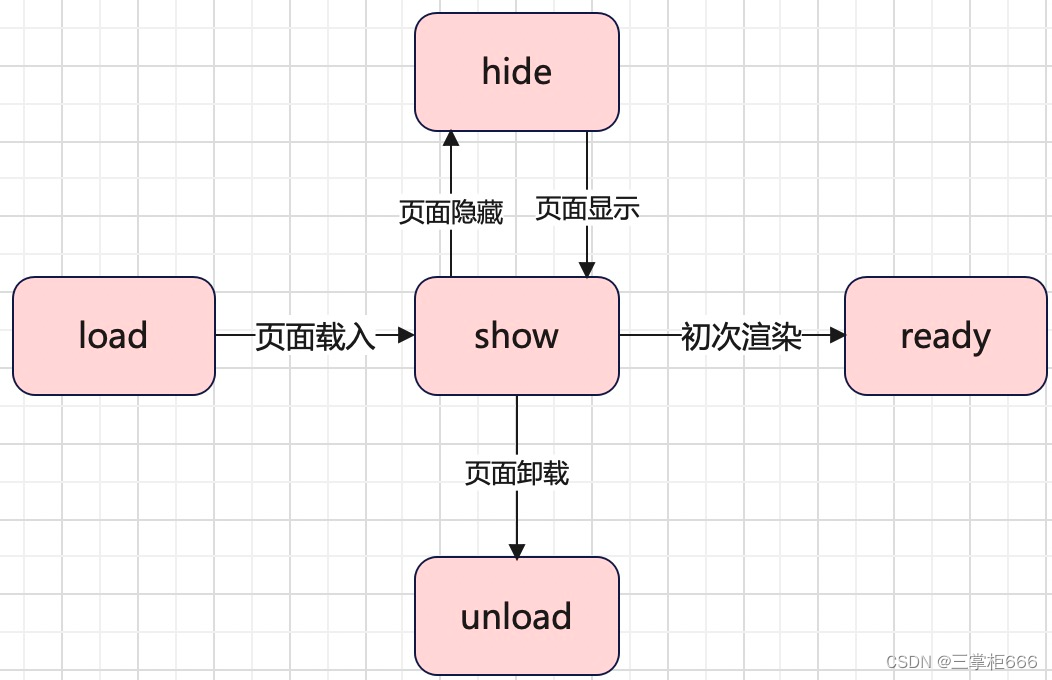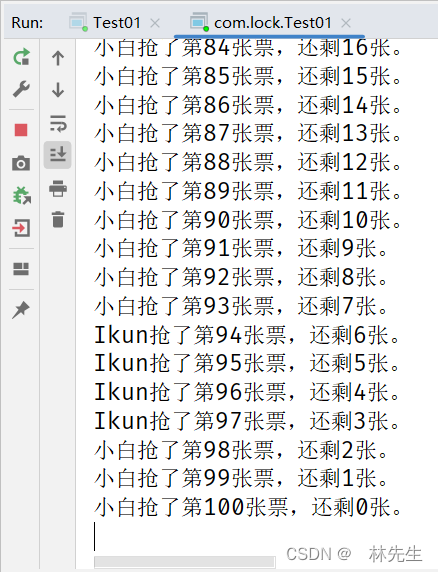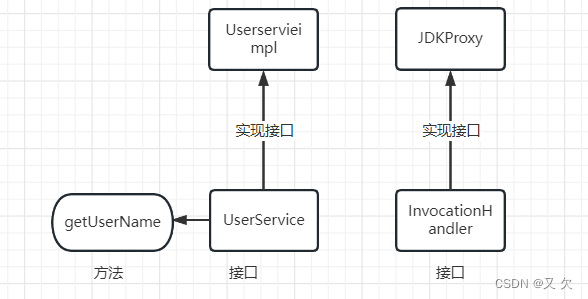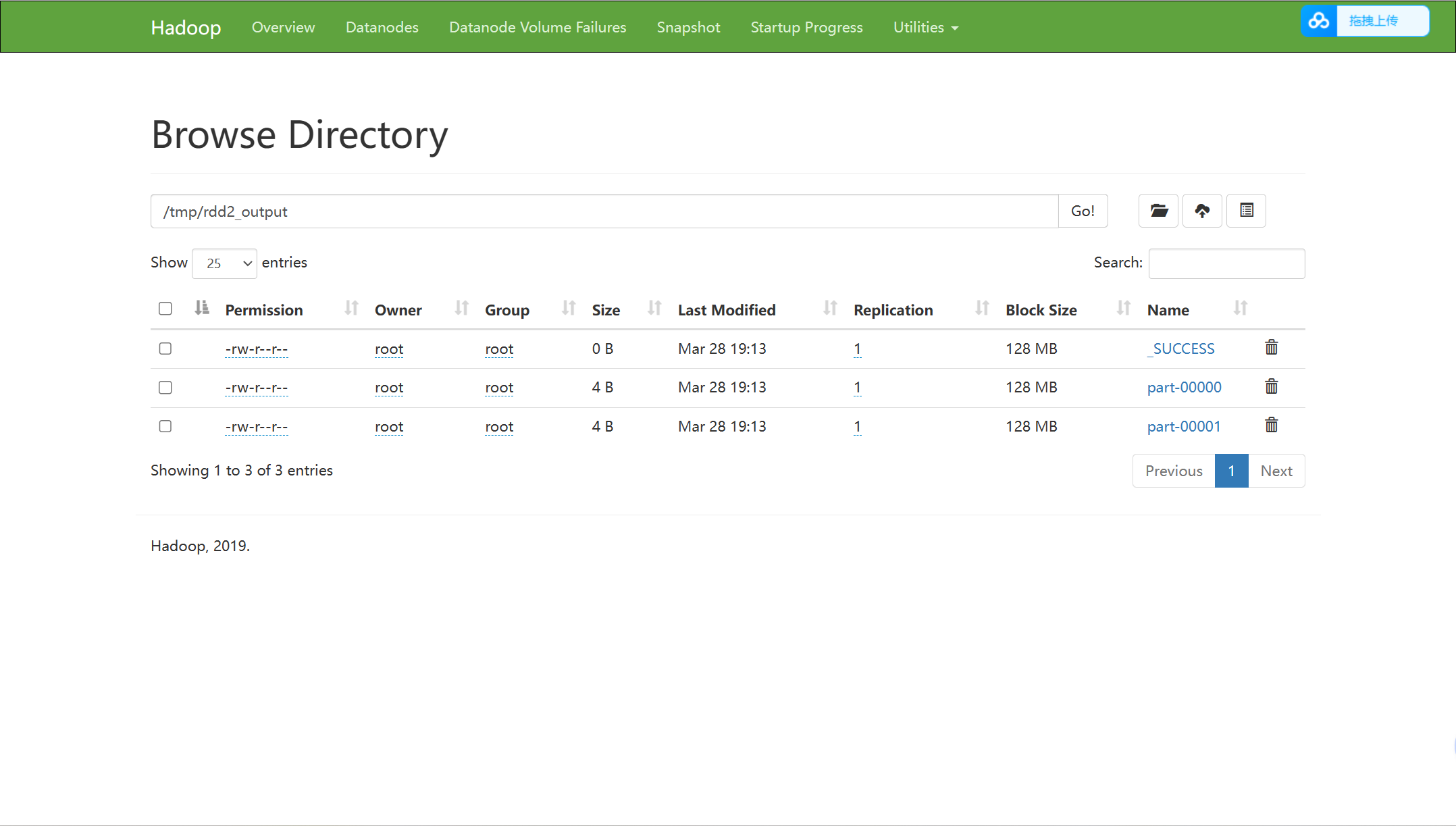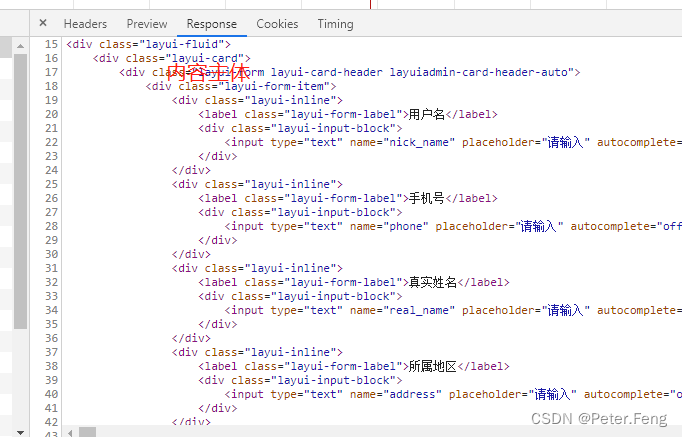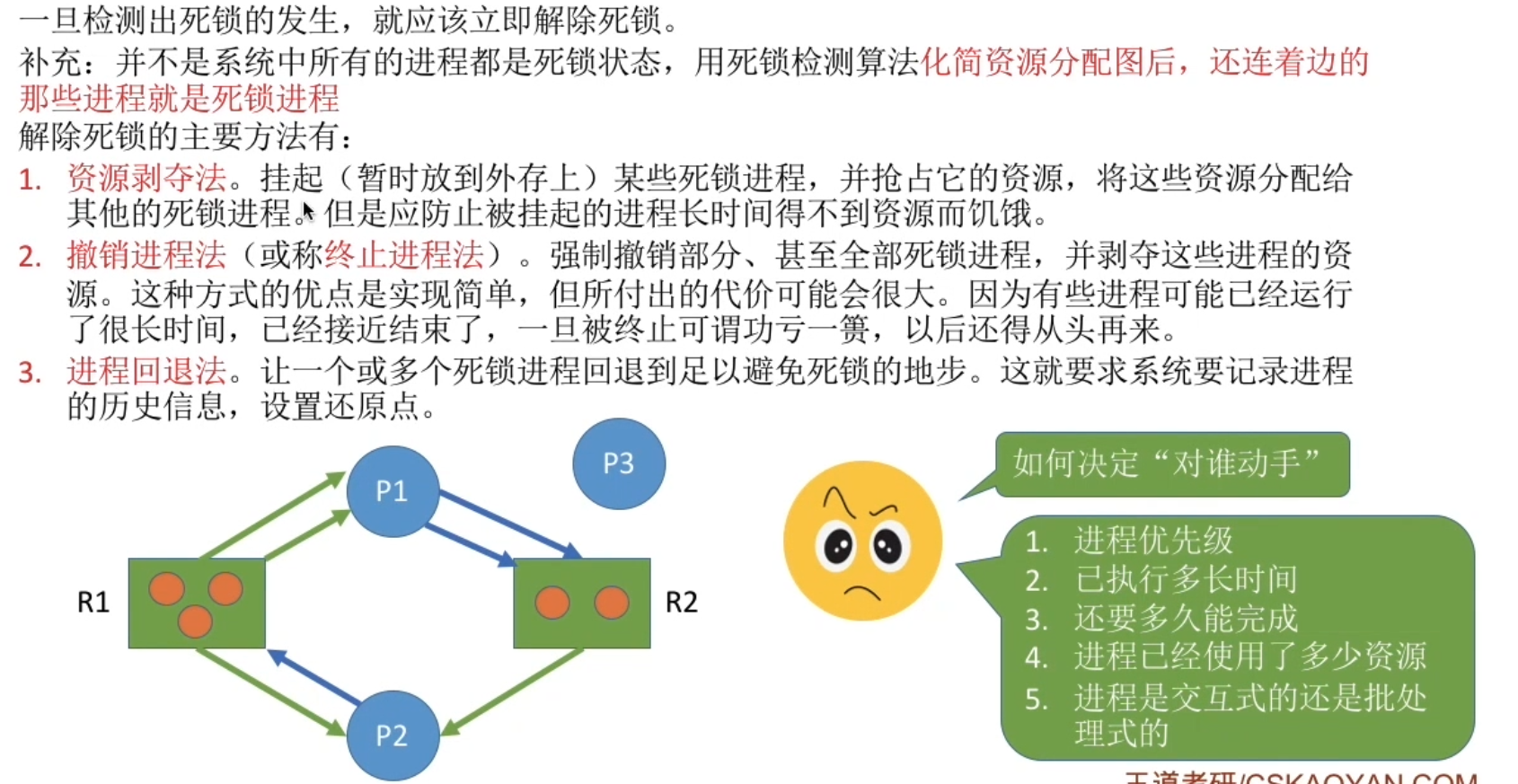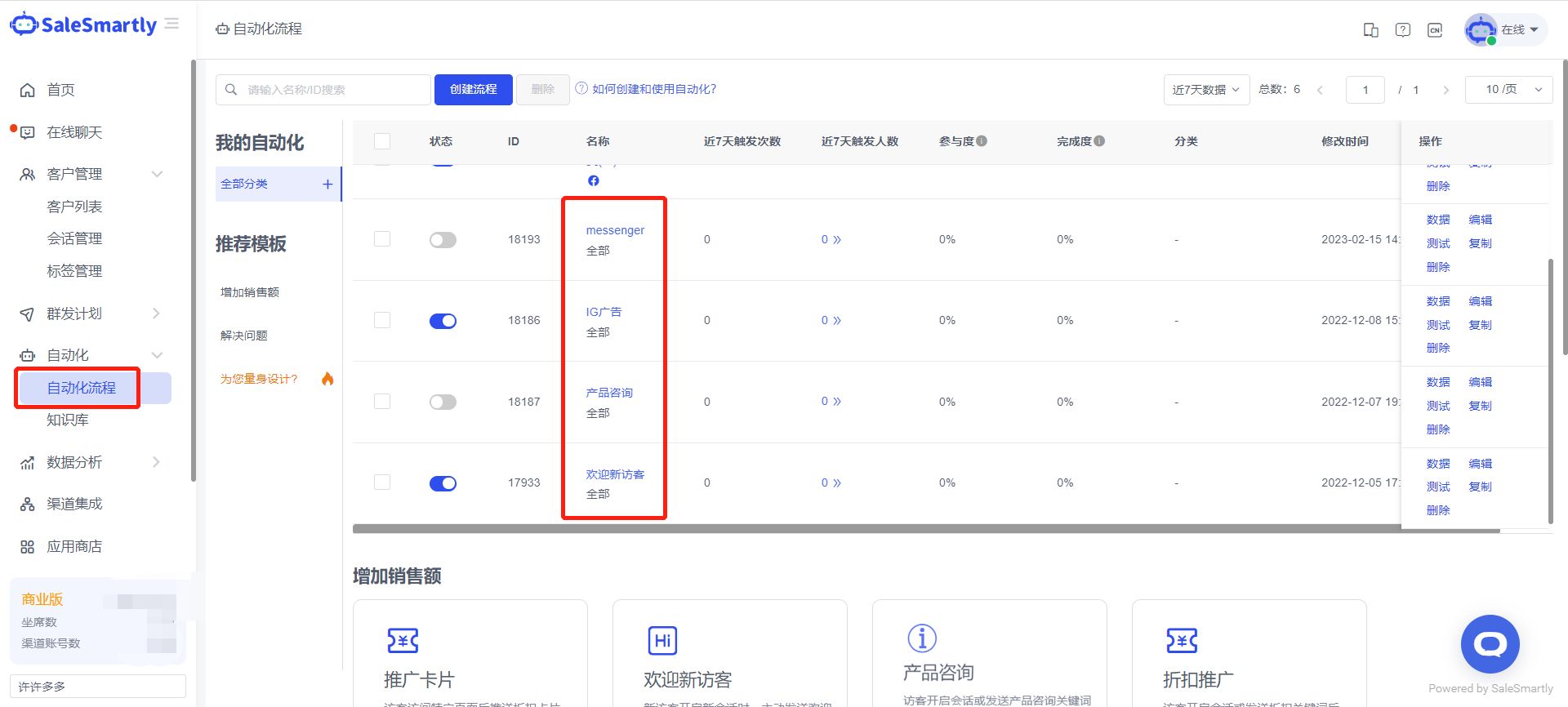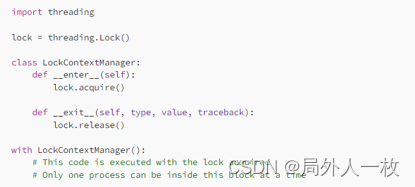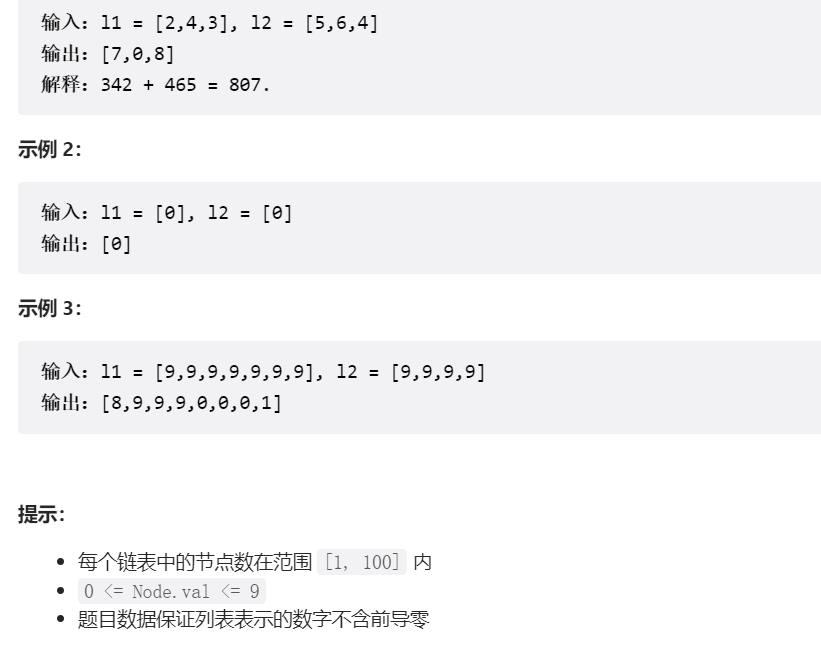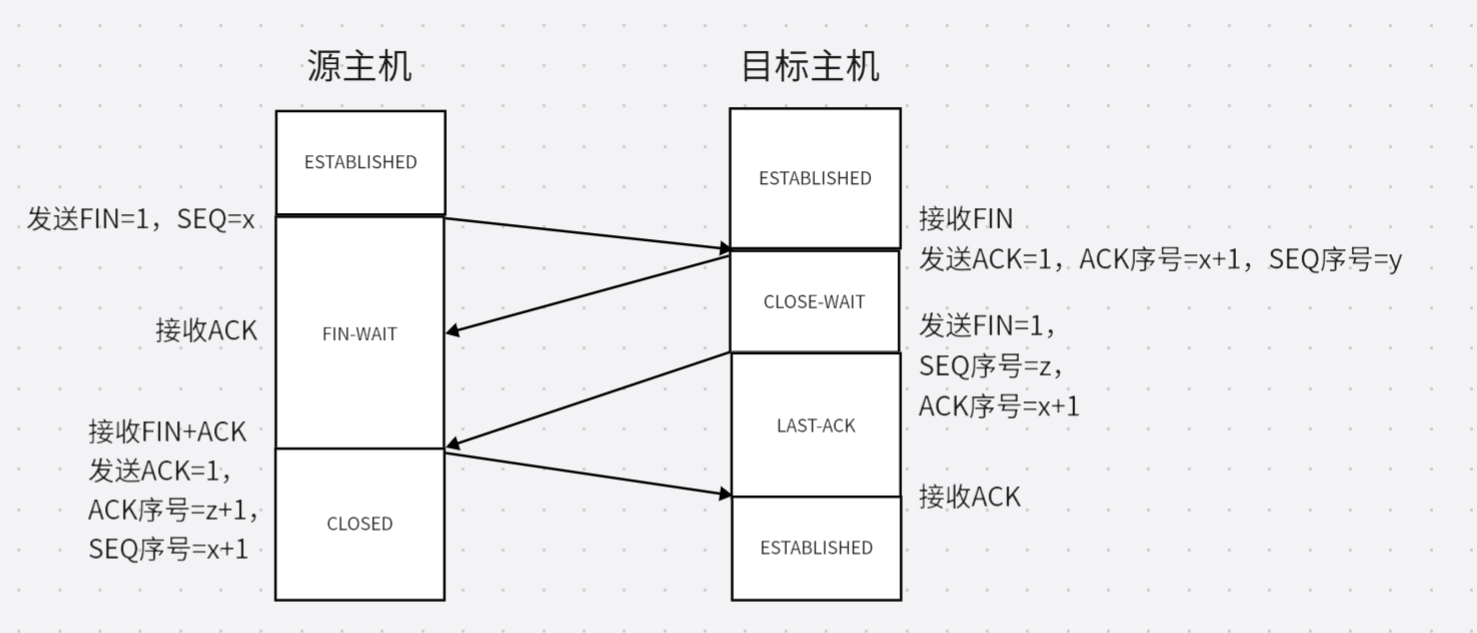SpringMVC
是隶属于
Spring
框架的一部分,主要是用来进行
Web
开发,是对
Servlet
进行了封装。
对于
SpringMVC
我们主要学习如下内容
:
- SpringMVC简介
- 请求与响应
- REST风格
- SSM整合(注解版)
- 拦截器
SpringMVC
是处于
Web
层的框架,所以其主要的作用就是用来接收前端发过来的请求和数据然后经过 处理并将处理的结果响应给前端,所以如何处理请求和响应是SpringMVC
中非常重要的一块内容。
REST
是一种软件架构风格,可以降低开发的复杂性,提高系统的可伸缩性,后期的应用也是非常广 泛。
SSM
整合是把咱们所学习的
SpringMVC+Spring+Mybatis
整合在一起来完成业务开发,是对我们所
学习这三个框架的一个综合应用。
对于
SpringMVC
的学习,最终要达成的目标
:
1.
掌握基于
SpringMVC
获取请求参数和响应
json
数据操作
2.
熟练应用基于
REST
风格的请求路径设置与参数传递
3.
能够根据实际业务建立前后端开发通信协议并进行实现
4.
基于
SSM
整合技术开发任意业务模块功能
一、SpringMVC概述
学习
SpringMVC
我们先来回顾下现在
web
程序是如何做的,咱们现在
web
程序大都基于三层架构来实 现。
三层架构
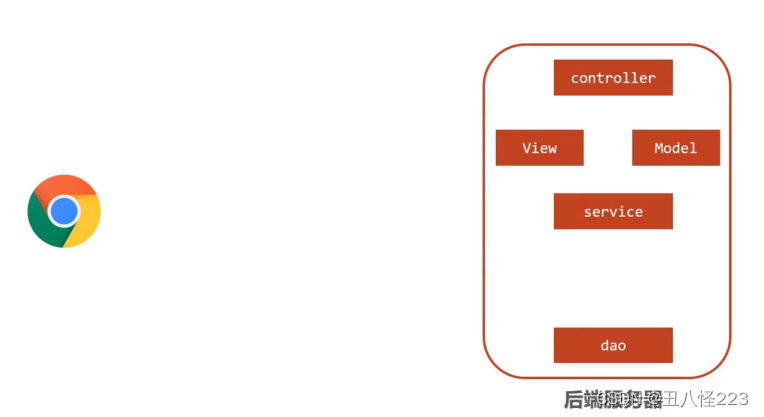
- 浏览器发送一个请求给后端服务器,后端服务器现在是使用Servlet来接收请求和数据
- 如果所有的处理都交给Servlet来处理的话,所有的东西都耦合在一起,对后期的维护和扩展极为 不利
- 将后端服务器Servlet拆分成三层,分别是web、service和dao
web
层主要由
servlet
来处理,负责页面请求和数据的收集以及响应结果给前端
service
层主要负责业务逻辑的处理
dao
层主要负责数据的增删改查操作
- servlet处理请求和数据的时候,存在的问题是一个servlet只能处理一个请求
- 针对web层进行了优化,采用了MVC设计模式,将其设计为controller、view和Model
controller
负责请求和数据的接收,接收后将其转发给
service
进行业务处理
service
根据需要会调用
dao
对数据进行增删改查
dao
把数据处理完后将结果交给
service,service
再交给
controller
controller
根据需求组装成
Model
和
View,Model
和
View
组合起来生成页面转发给前端浏览
器
这样做的好处就是
controller
可以处理多个请求,并对请求进行分发,执行不同的业务操
作。
随着互联网的发展,上面的模式因为是同步调用,性能慢慢的跟不是需求,所以异步调用慢慢的走到 了前台,是现在比较流行的一种处理方式。
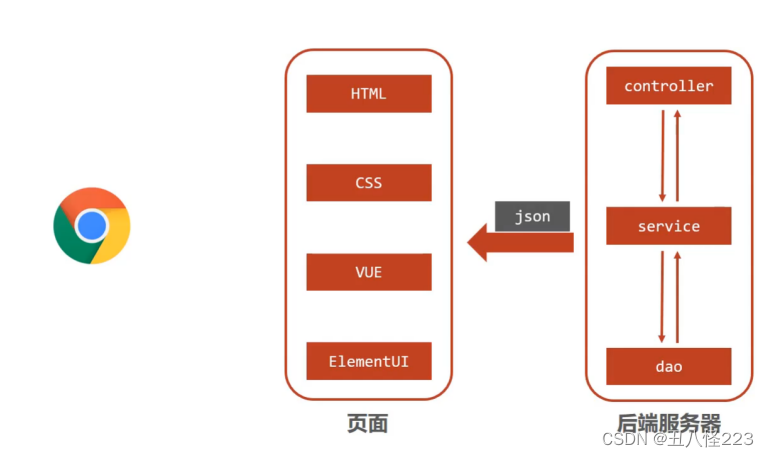
- 因为是异步调用,所以后端不需要返回view视图,将其去除
- 前端如果通过异步调用的方式进行交互,后台就需要将返回的数据转换成json格式进行返回
- SpringMVC主要负责的就是
controller
如何接收请求和数据
如何将请求和数据转发给业务层
如何将响应数据转换成
json
发回到前端
介绍了这么多,对
SpringMVC
进行一个定义
- SpringMVC是一种基于Java实现MVC模型的轻量级Web框架
- 优点
使用简单、开发便捷
(
相比于
Servlet)
灵活性强
这里所说的优点,就需要我们在使用的过程中慢慢体会。
二、SpringMVC入门案例
因为
SpringMVC
是一个
Web
框架,将来是要替换
Servlet,
所以先来回顾下以前
Servlet
是如何进行
开发的
?
1.
创建
web
工程
(Maven
结构
)
2.
设置
tomcat
服务器,加载
web
工程
(tomcat
插件
)
3.
导入坐标
(Servlet)
4.
定义处理请求的功能类
(UserServlet)
5.
设置请求映射
(
配置映射关系
)
SpringMVC
的制作过程和上述流程几乎是一致的,具体的实现流程是什么
?
1.
创建
web
工程
(Maven
结构
)
2.
设置
tomcat
服务器,加载
web
工程
(tomcat
插件
)
3.
导入坐标
(
SpringMVC
+Servlet)
4.
定义处理请求的功能类
(
UserController
)
5.
设置请求映射
(
配置映射关系
)
6.
将
SpringMVC
设定加载到
Tomcat
容器中
2.1 需求分析
2.2 案例制作
步骤
1:
创建
Maven
项目
打开
IDEA,
创建一个新的
web
项目

步骤
2:
补全目录结构
因为使用骨架创建的项目结构不完整,需要手动补全

步骤
3:
导入
jar
包
将
pom.xml
中多余的内容删除掉,再添加
SpringMVC
需要的依赖
1
<?
xml version
=
"1.0"
encoding
=
"UTF-8"
?>
2
<
project xmlns
=
"http://maven.apache.org/POM/4.0.0"
xmlns
:
xsi
=
"http://www.w3.org/2001/XMLSchema-instance"
3
xsi
:
schemaLocation
=
"http://maven.apache.org/POM/4.0.0
http://maven.apache.org/xsd/maven-4.0.0.xsd"
>
4
<
modelVersion
>
4.0
.
0
</
modelVersion
>
5
<
groupId
>
com
.
itheima
</
groupId
>
6
<
artifactId
>
springmvc_01_quickstart
</
artifactId
>
7
<
version
>
1.0
-
SNAPSHOT
</
version
>
8
<
packaging
>
war
</
packaging
>
9
10
<
dependencies
>
11
<
dependency
>
12
<
groupId
>
javax
.
servlet
</
groupId
>
13
<
artifactId
>
javax
.
servlet
-
api
</
artifactId
>
14
<
version
>
3.1
.
0
</
version
>
15
<
scope
>
provided
</
scope
>
16
</
dependency
>
17
<
dependency
>
18
<
groupId
>
org
.
springframework
</
groupId
>
19
<
artifactId
>
spring
-
webmvc
</
artifactId
>
20
<
version
>
5.2
.
10.
RELEASE
</
version
>
21
</
dependency
>
22
</
dependencies
>
23
24
<
build
>
25
<
plugins
>
26
<
plugin
>
27
<
groupId
>
org
.
apache
.
tomcat
.
maven
</
groupId
>
28
<
artifactId
>
tomcat7
-
maven
-
plugin
</
artifactId
>
29
<
version
>
2.1
</
version
>
30
<
configuration
>
31
<
port
>
80
</
port
>
32
<
path
>/</
path
>
33
</
configuration
>
34
</
plugin
>
35
</
plugins
>
36
</
build
>
37
</
project
>
38
说明
:
servlet
的坐标为什么需要添加
<scope>provided</scope>
?
- scope是maven中jar包依赖作用范围的描述,
- 如果不设置默认是compile在在编译、运行、测试时均有效
- 如果运行有效的话就会和tomcat中的servlet-api包发生冲突,导致启动报错
- provided代表的是该包只在编译和测试的时候用,运行的时候无效直接使用tomcat中的,就避
免冲突
步骤
4:
创建配置类
@Configuration
@ComponentScan
(
"com.itheima.controller"
)
public class
SpringMvcConfig
{
}
步骤
5:
创建
Controller
类
@Controller
public class
UserController
{
@RequestMapping
(
"/save"
)
public
void
save
(){
System
.
out
.
println
(
"user save ..."
);
}
}
步骤
6:
使用配置类替换
web.xml
将
web.xml
删除,换成
ServletContainersInitConfig
public class
ServletContainersInitConfig
extends
AbstractDispatcherServletInitializer
{
//
加载
springmvc
配置类
protected
WebApplicationContext createServletApplicationContext
() {
//
初始化
WebApplicationContext
对象
AnnotationConfigWebApplicationContext ctx
=
new
AnnotationConfigWebApplicationContext
();
//
加载指定配置类
ctx
.
register
(
SpringMvcConfig
.
class
);
return
ctx
;
}
//
设置由
springmvc
控制器处理的请求映射路径
protected
String
[]
getServletMappings
() {
return new
String
[]{
"/"
};
}
//
加载
spring
配置类
protected
WebApplicationContext createRootApplicationContext
() {
return
null
;
}
}
步骤
7:
配置
Tomcat
环境
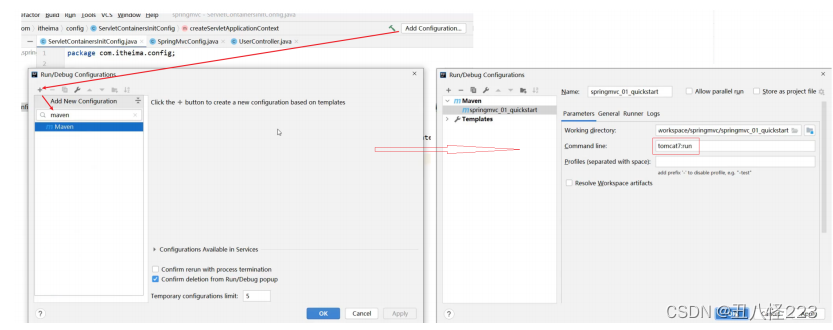
步骤
8:
启动运行项目

步骤
9:
浏览器访问
浏览器输入
http://localhost/save
进行访问,会报如下错误
:

页面报错的原因是后台没有指定返回的页面,目前只需要关注控制台看
user save ...
有没有被执行
即可。
步骤
10:
修改
Controller
返回值解决上述问题
前面我们说过现在主要的是前端发送异步请求,后台响应
json
数据,所以接下来我们把
Controller
类的
save
方法进行修改
@Controller
public class
UserController
{
@RequestMapping
(
"/save"
)
public
String
save
(){
System
.
out
.
println
(
"user save ..."
);
return
"{'info':'springmvc'}"
;
}
}
再次重启
tomcat
服务器,然后重新通过浏览器测试访问
,
会发现还是会报错,这次的错是
404

出错的原因是,如果方法直接返回字符串,
springmvc
会把字符串当成页面的名称在项目中进行查找 返回,因为不存在对应返回值名称的页面,所以会报404
错误,找不到资源。
而我们其实是想要直接返回的是
json
数据,具体如何修改呢
?
步骤
11:
设置返回数据为
json
@Controller
public class
UserController
{
@RequestMapping
(
"/save"
)
@ResponseBody
public
String
save
(){
System
.
out
.
println
(
"user save ..."
);
return
"{'info':'springmvc'}"
;
}
}
再次重启
tomcat
服务器,然后重新通过浏览器测试访问,就能看到返回的结果数据

至此
SpringMVC
的入门案例就已经完成。
注意事项
- SpringMVC是基于Spring的,在pom.xml只导入了spring-webmvc jar包的原因是它会自动依赖
spring
相关坐标
- AbstractDispatcherServletInitializer类是SpringMVC提供的快速初始化Web3.0容器
的抽象类
- AbstractDispatcherServletInitializer提供了三个接口方法供用户实现
createServletApplicationContext
方法,创建
Servlet
容器时,加载
SpringMVC
对应
的
bean
并放入
WebApplicationContext
对象范围中,而
WebApplicationContext
的作用
范围为
ServletContext
范围,即整个
web
容器范围
getServletMappings
方法,设定
SpringMVC
对应的请求映射路径,即
SpringMVC
拦截哪些
请求
createRootApplicationContext
方法,如果创建
Servlet
容器时需要加载非
SpringMVC
对应的
bean,
使用当前方法进行,使用方式和
createServletApplicationContext
相同。
createServletApplicationContext
用来加载
SpringMVC
环境
createRootApplicationContext
用来加载
Spring
环境
知识点
1
:
@Controller

知识点
2
:
@RequestMapping

知识点
3
:
@ResponseBody

2.3 入门案例总结
- 一次性工作
创建工程,设置服务器,加载工程
导入坐标
创建
web
容器启动类,加载
SpringMVC
配置,并设置
SpringMVC
请求拦截路径
SpringMVC
核心配置类(设置配置类,扫描
controller
包,加载
Controller
控制器
bean
)
- 多次工作
定义处理请求的控制器类
定义处理请求的控制器方法,并配置映射路径(
@RequestMapping
)与返回
json
数据
(
@ResponseBody
)
2.4 工作流程解析
为了更好的使用
SpringMVC,
我们将
SpringMVC
的使用过程总共分两个阶段来分析,分别是
启动服务 器初始化过程和
单次请求过程
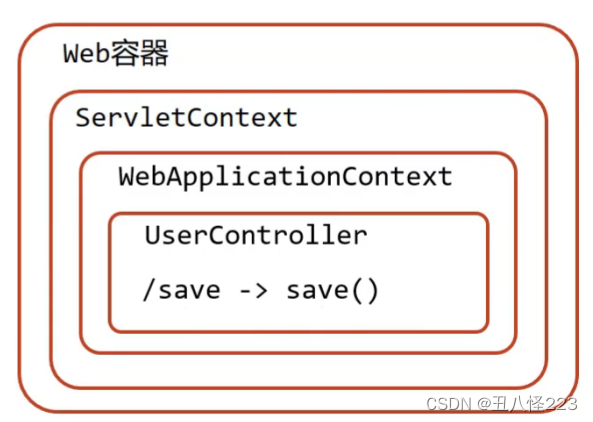
1.启动服务器初始化过程
1.
服务器启动,执行
ServletContainersInitConfig
类,初始化
web
容器
功能类似于以前的
web.xml
2.
执行
createServletApplicationContext
方法,创建了
WebApplicationContext
对象
该方法加载
SpringMVC
的配置类
SpringMvcConfig
来初始化
SpringMVC
的容器
3.
加载
SpringMvcConfig
配置类

4.
执行
@ComponentScan
加载对应的
bean
扫描指定包及其子包下所有类上的注解,如
Controller
类上的
@Controller
注解
5.
加载
UserController
,每个
@RequestMapping
的名称对应一个具体的方法
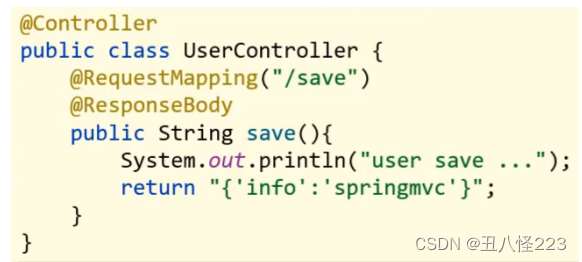
此时就建立了
/save
和
save
方法的对应关系
6.
执行
getServletMappings
方法,设定
SpringMVC
拦截请求的路径规则

/
代表所拦截请求的路径规则,只有被拦截后才能交给
SpringMVC
来处理请求
2.单次请求过程
1.
发送请求
http://localhost/save
2. web
容器发现该请求满足
SpringMVC
拦截规则,将请求交给
SpringMVC
处理
3.
解析请求路径
/save
4.
由
/save
匹配执行对应的方法
save(
)
上面的第五步已经将请求路径和方法建立了对应关系,通过
/save
就能找到对应的
save
方法
5.
执行
save()
6.
检测到有
@ResponseBody
直接将
save()
方法的返回值作为响应体返回给请求方
2.5 bean加载控制
1.问题分析
入门案例的内容已经做完了,在入门案例中我们创建过一个
SpringMvcConfig
的配置类,再回想前面 咱们学习Spring
的时候也创建过一个配置类
SpringConfig
。这两个配置类都需要加载资源,那么它 们分别都需要加载哪些内容?
我们先来看下目前我们的项目目录结构
:
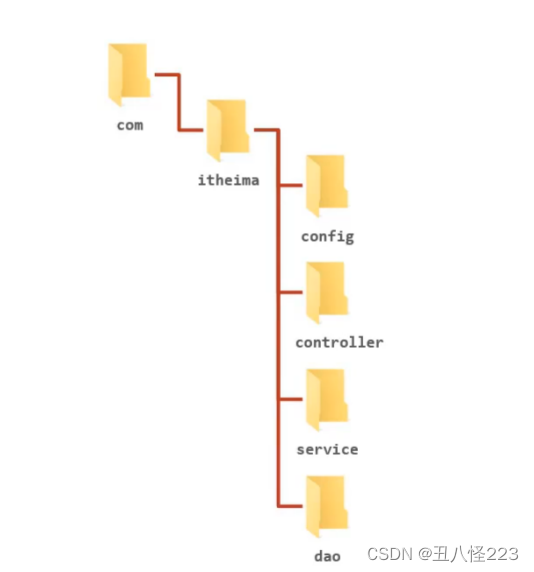
- config目录存入的是配置类,写过的配置类有:
ServletContainersInitConfig
SpringConfig
SpringMvcConfig
JdbcConfig
MybatisConfig
- controller目录存放的是SpringMVC的controller类
- service目录存放的是service接口和实现类
- dao目录存放的是dao/Mapper接口
controller
、
service
和
dao
这些类都需要被容器管理成
bean
对象,那么到底是该让
SpringMVC
加
载还是让
Spring
加载呢
?
- SpringMVC加载其相关bean(表现层bean),也就是controller包下的类
- Spring控制的bean
业务bean(Service)
功能
bean(DataSource,SqlSessionFactoryBean,MapperScannerConfigurer
等
)
分析清楚谁该管哪些
bean
以后,接下来要解决的问题是如何让
Spring
和
SpringMVC
分开加载各自的 内容。
在
SpringMVC
的配置类
SpringMvcConfig
中使用注解
@ComponentScan
,我们只需要将其扫描范围设 置到controller
即可,如

在
Spring
的配置类
SpringConfig
中使用注解
@ComponentScan
,
当时扫描的范围中其实是已经包含
了
controller,
如
:

从包结构来看的话,
Spring
已经多把
SpringMVC
的
controller
类也给扫描到,所以针对这个问题
该如何解决,就是咱们接下来要学习的内容。
概括的描述下咱们现在的问题就是
因为功能不同,如何避免
Spring
错误加载到
SpringMVC
的
bean?
2.思路分析
针对上面的问题,解决方案也比较简单,就是
:
- 加载Spring控制的bean的时候排除掉SpringMVC控制的bean
具体该如何排除:
- 方式一:Spring加载的bean设定扫描范围为精准范围,例如service包、dao包等
- 方式二:Spring加载的bean设定扫描范围为com.itheima,排除掉controller包中的bean
- 方式三:不区分Spring与SpringMVC的环境,加载到同一个环境中[了解即可]
4.环境准备
创建一个
Web
的
Maven
项目
pom.xml
添加
Spring
依赖
1
<?xml version="1.0" encoding="UTF-8"?>
2
3
<project
xmlns
=
"http://maven.apache.org/POM/4.0.0"
xmlns:xsi
=
"http://www.w3.org/2001/XMLSchema-instance"
4
xsi:schemaLocation
=
"http://maven.apache.org/POM/4.0.0
http://maven.apache.org/xsd/maven-4.0.0.xsd"
>
5
<modelVersion>
4.0.0
</modelVersion>
6
7
<groupId>
com.itheima
</groupId>
8
<artifactId>
springmvc_02_bean_load
</artifactId>
9<version>
1.0-SNAPSHOT
</version>
10
<packaging>
war
</packaging>
11
12
<dependencies>
13
<dependency>
14
<groupId>
javax.servlet
</groupId>
15
<artifactId>
javax.servlet-api
</artifactId>
16
<version>
3.1.0
</version>
17
<scope>
provided
</scope>
18
</dependency>
19
<dependency>
20
<groupId>
org.springframework
</groupId>
21
<artifactId>
spring-webmvc
</artifactId>
22
<version>
5.2.10.RELEASE
</version>
23
</dependency>
24
<dependency>
25
<groupId>
com.alibaba
</groupId>
26
<artifactId>
druid
</artifactId>
27
<version>
1.1.16
</version>
28
</dependency>
29
30
<dependency>
31
<groupId>
org.mybatis
</groupId>
32
<artifactId>
mybatis
</artifactId>
33
<version>
3.5.6
</version>
34
</dependency>
35
36
<dependency>
37
<groupId>
mysql
</groupId>
38
<artifactId>
mysql-connector-java
</artifactId>
39
<version>
5.1.47
</version>
40
</dependency>
41
42
<dependency>
43
<groupId>
org.springframework
</groupId>
44
<artifactId>
spring-jdbc
</artifactId>
45
<version>
5.2.10.RELEASE
</version>
46
</dependency>
47
48
<dependency>
49
<groupId>
org.mybatis
</groupId>
50
<artifactId>
mybatis-spring
</artifactId>
51
<version>
1.3.0
</version>
52
</dependency>
53
</dependencies>
54
55
<build>
56
<plugins>
57
<plugin>
58
<groupId>
org.apache.tomcat.maven
</groupId>
59
<artifactId>
tomcat7-maven-plugin
</artifactId>
60
<version>
2.1
</version>
61
<configuration>
62
<port>
80
</port>
63
<path>
/
</path>
64
</configuration>
65
</plugin>
66
</plugins>
67
</build>
68
</project>
69
- 创建对应的配置类
1
public class
ServletContainersInitConfig
extends
AbstractDispatcherServletInitializer
{
2
protected
WebApplicationContext createServletApplicationContext
() {
3
AnnotationConfigWebApplicationContext ctx
=
new
AnnotationConfigWebApplicationContext
();
4
ctx
.
register
(
SpringMvcConfig
.
class
);
5
return
ctx
;
6
}
7
protected
String
[]
getServletMappings
() {
8
return new
String
[]{
"/"
};
9
}
10
protected
WebApplicationContext createRootApplicationContext
() {
11
return
null
;
12
}
13
}
14
15
@Configuration
16
@ComponentScan
(
"com.itheima.controller"
)
17
public class
SpringMvcConfig
{
18
}
19
20
@Configuration
21
@ComponentScan
(
"com.itheima"
)
22
public class
SpringConfig
{
23
}
24
- 编写Controller,Service,Dao,Domain类
1
@Controller
2
public class
UserController
{
3
4
@RequestMapping
(
"/save"
)
5
@ResponseBody
6
public
String
save
(){
7
System
.
out
.
println
(
"user save ..."
);
8
return
"{'info':'springmvc'}"
;
最终创建好的项目结构如下
:
2.5.5
设置
bean
加载控制
方式一
:
修改
Spring
配置类,设定扫描范围为精准范围。
}
}
public interface
UserService
{
public
void
save
(
User user
);
}
@Service
public class
UserServiceImpl
implements
UserService
{
public
void
save
(
User user
) {
System
.
out
.
println
(
"user service ..."
);
}
}
public interface
UserDao
{
@Insert
(
"insert into tbl_user(name,age)values(#{name},#{age})"
)
public
void
save
(
User user
);
}
public class
User
{
private
Integer
id
;
private
String
name
;
private
Integer
age
;
//setter..getter..toString
略
}
最终创建好的项目结构如下
:
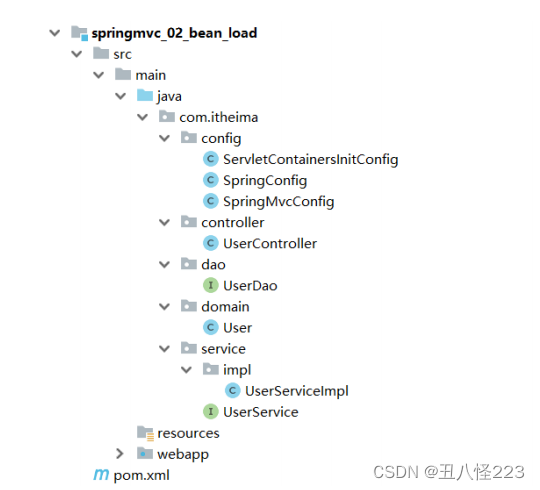
5.设置bean加载控制
方式一
:
修改
Spring
配置类,设定扫描范围为精准范围。
1@Configuration
2
@ComponentScan
({
"com.itheima.service"
,
"comitheima.dao"
})
3
public class
SpringConfig
{
4
}
说明
:
上述只是通过例子说明可以精确指定让
Spring
扫描对应的包结构,真正在做开发的时候,因为
Dao
最 终是交给MapperScannerConfigurer
对象来进行扫描处理的,我们只需要将其扫描到
service
包即 可。
方式二
:
修改
Spring
配置类,设定扫描范围为
com.itheima,
排除掉
controller
包中的
bean
1
@Configuration
2
@ComponentScan
(
value
=
"com.itheima"
,
3
excludeFilters
=
@ComponentScan
.
Filter
(
4
type
=
FilterType
.
ANNOTATION
,
5
classes
=
Controller
.
class
6
)
7
)
8
public class
SpringConfig
{
9
}
- excludeFilters属性:设置扫描加载bean时,排除的过滤规则
- type属性:设置排除规则,当前使用按照bean定义时的注解类型进行排除
ANNOTATION
:按照注解排除
ASSIGNABLE_TYPE:
按照指定的类型过滤
ASPECTJ:
按照
Aspectj
表达式排除,基本上不会用
REGEX:
按照正则表达式排除
CUSTOM:
按照自定义规则排除
大家只需要知道第一种
ANNOTATION
即可
- classes属性:设置排除的具体注解类,当前设置排除@Controller定义的bean
如何测试
controller
类已经被排除掉了
?
1
public class
App
{
2
public static
void
main
(
String
[]
args
){
3
AnnotationConfigApplicationContext ctx
=
new
AnnotationConfigApplicationContext
(
SpringConfig
.
class
);
4
System
.
out
.
println
(
ctx
.
getBean
(
UserController
.
class
));
5
}
6
}
如果被排除了,该方法执行就会报
bean
未被定义的错误

注意
:
测试的时候,需要把
SpringMvcConfig
配置类上的
@ComponentScan
注解注释掉,否则不会
报错
出现问题的原因是,
- Spring配置类扫描的包是com.itheima
- SpringMVC的配置类,SpringMvcConfig上有一个@Configuration注解,也会被Spring扫描 到
- SpringMvcConfig上又有一个@ComponentScan,把controller类又给扫描进来了
- 所以如果不把@ComponentScan注释掉,Spring配置类将Controller排除,但是因为扫描到 SpringMVC的配置类,又将其加载回来,演示的效果就出不来
- 解决方案,也简单,把SpringMVC的配置类移出Spring配置类的扫描范围即可。
最后一个问题,有了
Spring
的配置类,要想在
tomcat
服务器启动将其加载,我们需要修改
ServletContainersInitConfig
1
public class
ServletContainersInitConfig
extends
AbstractDispatcherServletInitializer
{
2
protected
WebApplicationContext createServletApplicationContext
() {
3
AnnotationConfigWebApplicationContext ctx
=
new
AnnotationConfigWebApplicationContext
();
4
ctx
.
register
(
SpringMvcConfig
.
class
);
5
return
ctx
;
6
}
7
protected
String
[]
getServletMappings
() {
8
return new
String
[]{
"/"
};
9
}
10
protected
WebApplicationContext createRootApplicationContext
() {
11
AnnotationConfigWebApplicationContext ctx
=
new
AnnotationConfigWebApplicationContext
();
12
ctx
.
register
(
SpringConfig
.
class
);
13
return
ctx
;
14
}
15
}
对于上述的配置方式,
Spring
还提供了一种更简单的配置方式,可以不用再去创建
AnnotationConfigWebApplicationContext
对象,不用手动
register
对应的配置类,如何实现
?
public class
ServletContainersInitConfig
extends
AbstractAnnotationConfigDispatcherServletInitializer
{
protected
Class
<?>
[]
getRootConfigClasses
() {
return new
Class
[]{
SpringConfig
.
class
};
}
protected
Class
<?>
[]
getServletConfigClasses
() {
return new
Class
[]{
SpringMvcConfig
.
class
};
}
protected
String
[]
getServletMappings
() {
return new
String
[]{
"/"
};
}
}
知识点
1
:
@ComponentScan

三、PostMan工具的使用
3.1 PostMan简介
代码编写完后,我们要想测试,只需要打开浏览器直接输入地址发送请求即可。发送的是
GET
请求可 以直接使用浏览器,但是如果要发送的是POST
请求呢
?
如果要求发送的是
post
请求,我们就得准备页面在页面上准备
form
表单,测试起来比较麻烦。所以我 们就需要借助一些第三方工具,如PostMan.
- PostMan是一款功能强大的网页调试与发送网页HTTP请求的Chrome插件。
- 作用:常用于进行接口测试
- 特征
简单
实用
美观
大方
3.2 PostMan安装
双击
资料
\Postman
-
win64
-
8.3.1
-
Setup.exe
即可自动安装,
安装完成后,如果需要注册,可以按照提示进行注册,如果底部有跳过测试的链接也可以点击跳过注 册

看到如下界面,就说明已经安装成功。
3.3 PostMan使用
1. 创建WorkSpace工作空间
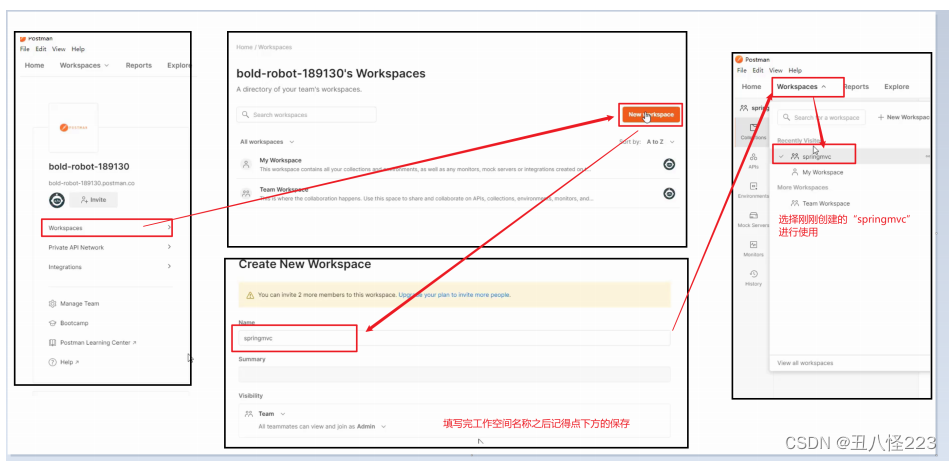
2. 发送请求
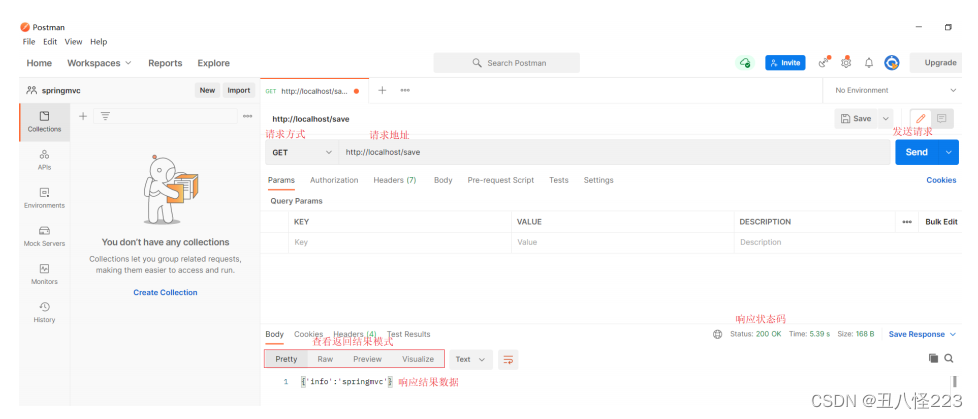
3. 保存当前请求
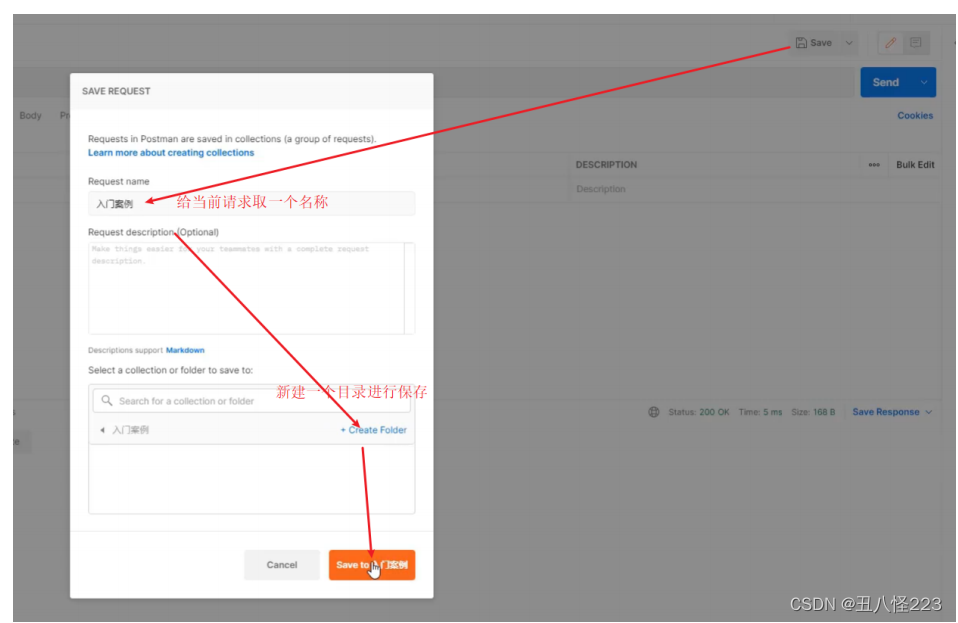
注意
:
第一次请求需要创建一个新的目录,后面就不需要创建新目录,直接保存到已经创建好的目录即 可。
四、请求与响应
前面我们已经完成了入门案例相关的知识学习,接来了我们就需要针对
SpringMVC
相关的知识点进行 系统的学习,之前我们提到过,SpringMVC
是
web
层的框架,主要的作用是接收请求、接收数据、响 应结果,所以这一章节是学习SpringMVC
的
重点
内容,我们主要会讲解四部分内容
:
- 请求映射路径
- 请求参数
- 日期类型参数传递
- 响应json数据
4.1 设置请求映射路径
1. 环境准备
- 创建一个Web的Maven项目
- pom.xml添加Spring依赖
<?xml version="1.0" encoding="UTF-8"?>
<project
xmlns
=
"http://maven.apache.org/POM/4.0.0"
xmlns:xsi
=
"http://www.w3.org/2001/XMLSchema-instance"
1
2
3
4
xsi:schemaLocation
=
"http://maven.apache.org/POM/4.0.0
http://maven.apache.org/xsd/maven-4.0.0.xsd"
>
5
<modelVersion>
4.0.0
</modelVersion>
6
7
<groupId>
com.itheima
</groupId>
8
<artifactId>
springmvc_03_request_mapping
</artifactId>
9
<version>
1.0-SNAPSHOT
</version>
10
<packaging>
war
</packaging>
11
12
<dependencies>
13
<dependency>
14
<groupId>
javax.servlet
</groupId>
15
<artifactId>
javax.servlet-api
</artifactId>
16
<version>
3.1.0
</version>
17
<scope>
provided
</scope>
18
</dependency>
19
<dependency>
20
<groupId>
org.springframework
</groupId>
21
<artifactId>
spring-webmvc
</artifactId>
22
<version>
5.2.10.RELEASE
</version>
23
</dependency>
24
</dependencies>
25
26
<build>
27
<plugins>
28
<plugin>
29
<groupId>
org.apache.tomcat.maven
</groupId>
30
<artifactId>
tomcat7-maven-plugin
</artifactId>
31
<version>
2.1
</version>
32
<configuration>
33
<port>
80
</port>
34
<path>
/
</path>
35
</configuration>
36
</plugin>
37
</plugins>
38
</build>
39
</project>
40
- 创建对应的配置类
1
public class
ServletContainersInitConfig
extends
AbstractAnnotationConfigDispatcherServletInitializer
{
2
3
protected
Class
<?>
[]
getServletConfigClasses
() {
4
return new
Class
[]{
SpringMvcConfig
.
class
};
5
}
6
protected
String
[]
getServletMappings
() {
7
return new
String
[]{
"/"
};
8
}
9
protected
Class
<?>
[]
getRootConfigClasses
() {
10
return new
Class
[
0
];
11
}
12
}
13
14
@Configuration
15
@ComponentScan
(
"com.itheima.controller"
)
16
public class
SpringMvcConfig
{
17
}
18
- 编写BookController和UserController
1
@Controller
2
public class
UserController
{
3
4
@RequestMapping
(
"/save"
)
5
@ResponseBody
6
public
String
save
(){
7
System
.
out
.
println
(
"user save ..."
);
8
return
"{'module':'user save'}"
;
9
}
10
11
@RequestMapping
(
"/delete"
)
12
@ResponseBody
13
public
String
save
(){
14
System
.
out
.
println
(
"user delete ..."
);
15
return
"{'module':'user delete'}"
;
16
}
17
}
18
19
@Controller
20
public class
BookController
{
21
22
@RequestMapping
(
"/save"
)
23
@ResponseBody
24
public
String
save
(){
25
System
.
out
.
println
(
"book save ..."
);
26
return
"{'module':'book save'}"
;
27
}
28
}
最终创建好的项目结构如下
:

把环境准备好后,启动
Tomcat
服务器,后台会报错
:
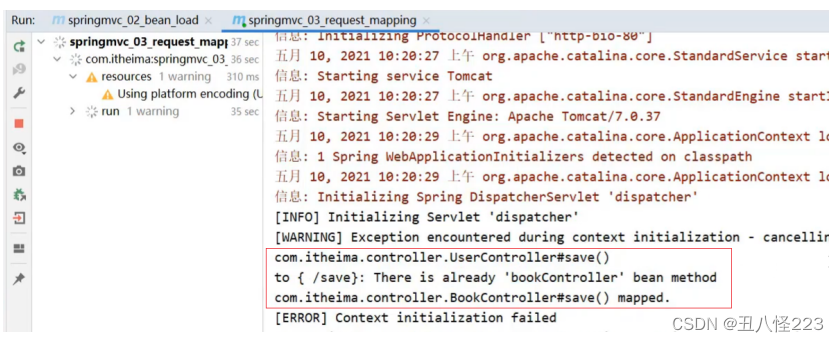
从错误信息可以看出
:
- UserController有一个save方法,访问路径为http://localhost/save
- BookController也有一个save方法,访问路径为http://localhost/save
- 当访问http://localhost/saved的时候,到底是访问UserController还是 BookController?
2 . 问题分析
团队多人开发,每人设置不同的请求路径,冲突问题该如何解决
?
解决思路
:
为不同模块设置模块名作为请求路径前置
对于
Book
模块的
save,
将其访问路径设置
http://localhost/book/save
对于
User
模块的
save,
将其访问路径设置
http://localhost/user/save
这样在同一个模块中出现命名冲突的情况就比较少了。
3. 设置映射路径
步骤
1:
修改
Controller
@Controller
public class
UserController
{
@RequestMapping
(
"/user/save"
)
@ResponseBody
public
String
save
(){
System
.
out
.
println
(
"user save ..."
);
return
"{'module':'user save'}"
;
}
@RequestMapping
(
"/user/delete"
)
@ResponseBody
public
String
save
(){
System
.
out
.
println
(
"user delete ..."
);
return
"{'module':'user delete'}"
;
}
}
@Controller
public class
BookController
{
@RequestMapping
(
"/book/save"
)
@ResponseBody
public
String
save
(){
System
.
out
.
println
(
"book save ..."
);
return
"{'module':'book save'}"
;
}
}
问题是解决了,但是每个方法前面都需要进行修改,写起来比较麻烦而且还有很多重复代码,如
果
/user
后期发生变化,所有的方法都需要改,耦合度太高。
步骤
2:
优化路径配置
优化方案
:
@Controller
@RequestMapping
(
"/user"
)
public class
UserController
{
@RequestMapping
(
"/save"
)
@ResponseBody
public
String
save
(){
System
.
out
.
println
(
"user save ..."
);
return
"{'module':'user save'}"
;
}
@RequestMapping
(
"/delete"
)
@ResponseBody
public
String
save
(){
System
.
out
.
println
(
"user delete ..."
);
return
"{'module':'user delete'}"
;
}
}
@Controller
@RequestMapping
(
"/book"
)
public class
BookController
{
@RequestMapping
(
"/save"
)
@ResponseBody
public
String
save
(){
System
.
out
.
println
(
"book save ..."
);
return
"{'module':'book save'}"
;
}
}
注意
:
- 当类上和方法上都添加了@RequestMapping注解,前端发送请求的时候,要和两个注解的value 值相加匹配才能访问到。
- @RequestMapping注解value属性前面加不加/都可以
扩展小知识
:
对于
PostMan
如何觉得字小不好看,可以使用
ctrl+=
调大,
ctrl+
-
调小。
4.2 请求参数
请求路径设置好后,只要确保页面发送请求地址和后台
Controller
类中配置的路径一致,就可以接
收到前端的请求,接收到请求后,如何接收页面传递的参数
?
关于请求参数的传递与接收是和请求方式有关系的,目前比较常见的两种请求方式为:
- GET
- POST
针对于不同的请求前端如何发送,后端如何接收
?
1. 环境准备
- 创建一个Web的Maven项目
- pom.xml添加Spring依赖
1
<?xml version="1.0" encoding="UTF-8"?>
2
3
<project
xmlns
=
"http://maven.apache.org/POM/4.0.0"
xmlns:xsi
=
"http://www.w3.org/2001/XMLSchema-instance"
4
xsi:schemaLocation
=
"http://maven.apache.org/POM/4.0.0
http://maven.apache.org/xsd/maven-4.0.0.xsd"
>
5
<modelVersion>
4.0.0
</modelVersion>
6
7
<groupId>
com.itheima
</groupId>
8
<artifactId>
springmvc_03_request_mapping
</artifactId>
9
<version>
1.0-SNAPSHOT
</version>
10
<packaging>
war
</packaging>
11
12
<dependencies>
13
<dependency>
14
<groupId>
javax.servlet
</groupId>
15
<artifactId>
javax.servlet-api
</artifactId>
16
<version>
3.1.0
</version>
17
<scope>
provided
</scope>
18
</dependency>
19
<dependency>
20
<groupId>
org.springframework
</groupId>
21
<artifactId>
spring-webmvc
</artifactId>
22
<version>
5.2.10.RELEASE
</version>
23
</dependency>
24
</dependencies>
25
26
<build>
27
<plugins>
28
<plugin>
29
<groupId>
org.apache.tomcat.maven
</groupId>
30
<artifactId>
tomcat7-maven-plugin
</artifactId>
31
<version>
2.1
</version>
32
<configuration>
33
<port>
80
</port>
34
<path>
/
</path>
35
</configuration>
36
</plugin>
37
</plugins>
38
</build>
39
</project>
40
- 创建对应的配置类
1
public class
ServletContainersInitConfig
extends
AbstractAnnotationConfigDispatcherServletInitializer
{
2
3
protected
Class
<?>
[]
getServletConfigClasses
() {
4
return new
Class
[]{
SpringMvcConfig
.
class
};
5
}
6
protected
String
[]
getServletMappings
() {
7
return new
String
[]{
"/"
};
8
}
9
protected
Class
<?>
[]
getRootConfigClasses
() {
10
return new
Class
[
0
];
11
}
12
}
13
14
@Configuration
15
@ComponentScan
(
"com.itheima.controller"
)
16
public class
SpringMvcConfig
{
17
}
18
- 编写UserController
1
@Controller
2
public class
UserController
{
3
4
@RequestMapping
(
"/commonParam"
)
5
@ResponseBody
6
public
String
commonParam
(){
7
return
"{'module':'commonParam'}"
;
8
}
9
}
- 编写模型类,User和Address
1
public class
Address
{
2
private
String
province
;
3
private
String
city
;
4
//setter...getter...
略
5
}
6
public class
User
{
7
private
String
name
;
8
private
int
age
;
9
//setter...getter...
略
10
}
最终创建好的项目结构如下
:
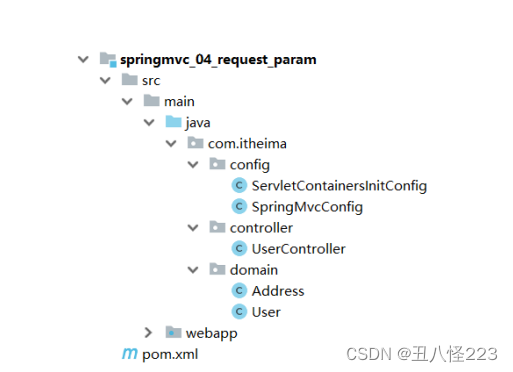
2. 参数传递
GET
发送单个参数
发送请求与参数
:
http://localhost/commonParam?name=itcast

接收参数:
@Controller
public class
UserController
{
@RequestMapping
(
"/commonParam"
)
@ResponseBody
public
String
commonParam
(
String
name
){
System
.
out
.
println
(
"
普通参数传递
name ==> "
+
name
);
return
"{'module':'commonParam'}"
;
}
}
GET
发送多个参数
发送请求与参数
:
http://localhost/commonParam?name=itcast&age=15

接收参数:
@Controller
public class
UserController
{
@RequestMapping
(
"/commonParam"
)
@ResponseBody
public
String
commonParam
(
String
name
,
int
age
){
System
.
out
.
println
(
"
普通参数传递
name ==> "
+
name
);
System
.
out
.
println
(
"
普通参数传递
age ==> "
+
age
);
return
"{'module':'commonParam'}"
;
}
}
GET
请求中文乱码
如果我们传递的参数中有中文,你会发现接收到的参数会出现中文乱码问题。
发送请求
:
http://localhost/commonParam?name=
张三
&age=18
控制台
:

出现乱码的原因相信大家都清楚,
Tomcat8.5
以后的版本已经处理了中文乱码的问题,但是
IDEA
中的
Tomcat
插件目前只到
Tomcat7
,所以需要修改
pom.xml
来解决
GET
请求中文乱码问题
<build>
<plugins>
<plugin>
<groupId>
org.apache.tomcat.maven
</groupId>
<artifactId>
tomcat7-maven-plugin
</artifactId>
<version>
2.1
</version>
<configuration>
<port>
80
</port>
<!--tomcat
端口号
-->
<path>
/
</path>
<!--
虚拟目录
-->
<uriEncoding>
UTF-8
</uriEncoding>
<!--
访问路径编解码字符集
-->
</configuration>
</plugin>
</plugins>
</build>
POST
发送参数
发送请求与参数
:
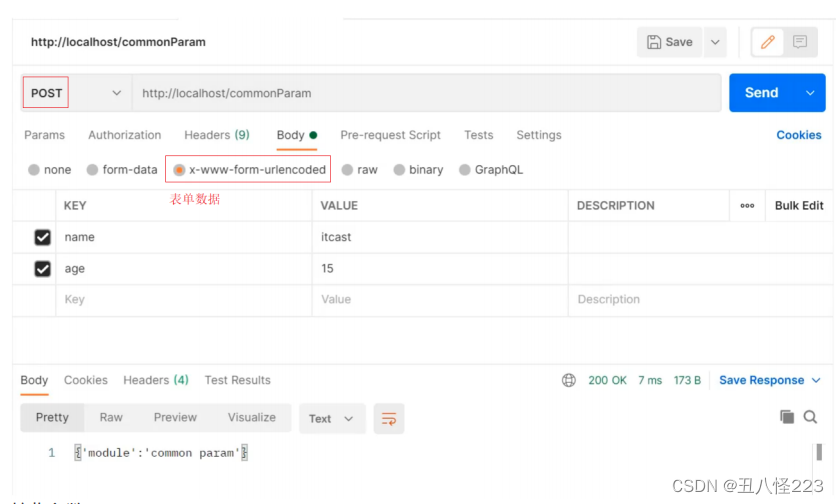
接收参数:
和
GET
一致,不用做任何修改
@Controller
public class
UserController
{
@RequestMapping
(
"/commonParam"
)
@ResponseBody
public
String
commonParam
(
String
name
,
int
age
){
System
.
out
.
println
(
"
普通参数传递
name ==> "
+
name
);
System
.
out
.
println
(
"
普通参数传递
age ==> "
+
age
);
return
"{'module':'commonParam'}"
;
}
}
POST
请求中文乱码
发送请求与参数
:
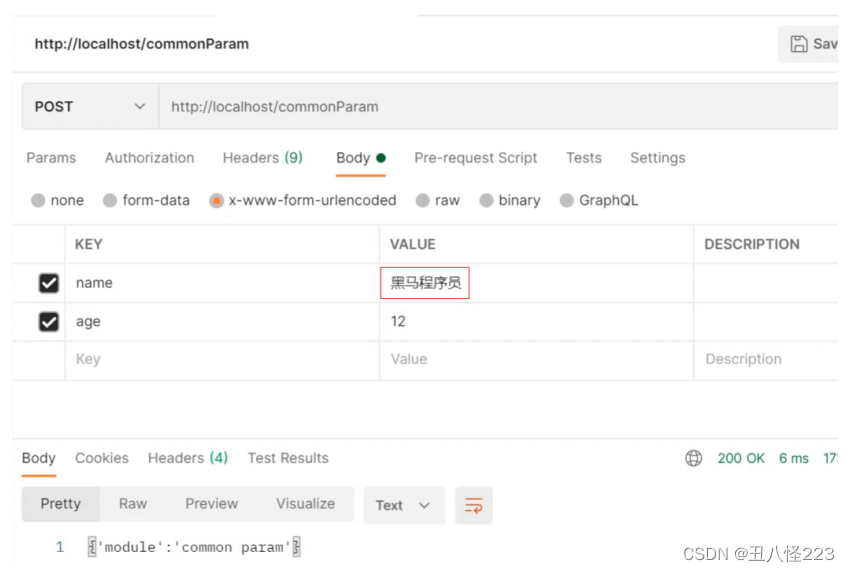
接收参数
:
控制台打印,会发现有中文乱码问题。

解决方案
:
配置过滤器
public class
ServletContainersInitConfig
extends
AbstractAnnotationConfigDispatcherServletInitializer
{
protected
Class
<?>
[]
getRootConfigClasses
() {
return new
Class
[
0
];
}
protected
Class
<?>
[]
getServletConfigClasses
() {
return new
Class
[]{
SpringMvcConfig
.
class
};
}
protected
String
[]
getServletMappings
() {
return new
String
[]{
"/"
};
}
//
乱码处理
@Override
protected
Filter
[]
getServletFilters
() {
CharacterEncodingFilter filter
=
new
CharacterEncodingFilter
();
filter
.
setEncoding
(
"UTF-8"
);
return new
Filter
[]{
filter
};
}
}
CharacterEncodingFilter
是在
spring-web
包中,所以用之前需要导入对应的
jar
包。
4.3 五种类型参数传递
前面我们已经能够使用
GET
或
POST
来发送请求和数据,所携带的数据都是比较简单的数据,接下来在 这个基础上,我们来研究一些比较复杂的参数传递,常见的参数种类有:
- 普通参数
- POJO类型参数
- 嵌套POJO类型参数
- 数组类型参数
- 集合类型参数
这些参数如何发送,后台改如何接收
?
我们一个个来学习。
1. 普通参数
- 普通参数:url地址传参,地址参数名与形参变量名相同,定义形参即可接收参数。
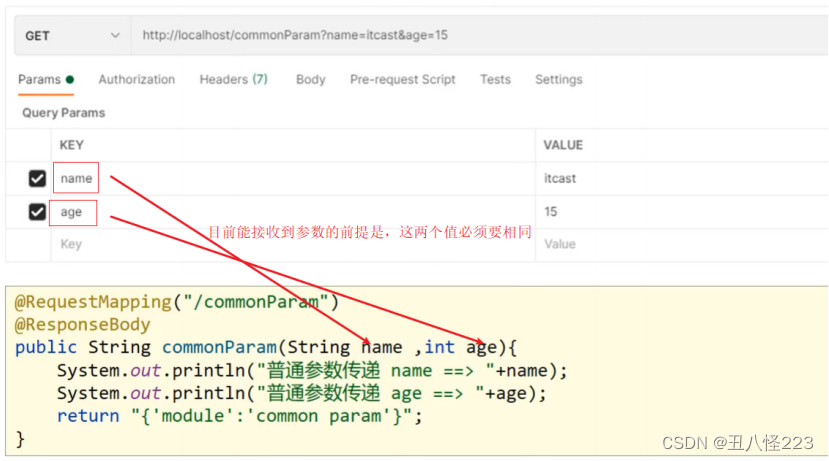
如果形参与地址参数名不一致该如何解决
?
发送请求与参数
:
http://localhost/commonParamDifferentName?name=
张三
&age=18
后台接收参数
:
@RequestMapping
(
"/commonParamDifferentName"
)
@ResponseBody
public
String
commonParamDifferentName
(
String
userName
,
int
age
){
System
.
out
.
println
(
"
普通参数传递
userName ==> "
+
userName
);
System
.
out
.
println
(
"
普通参数传递
age ==> "
+
age
);
return
"{'module':'common param different name'}"
;
}
因为前端给的是
name
,
后台接收使用的是
userName
,
两个名称对不上,导致接收数据失败
:

解决方案
:
使用
@RequestParam
注解
@RequestMapping
(
"/commonParamDifferentName"
)
@ResponseBody
public
String
commonParamDifferentName
(
@RequestPaam
(
"name"
)
String
userName
,
int
age
){
System
.
out
.
println
(
"
普通参数传递
userName ==> "
+
userName
);
System
.
out
.
println
(
"
普通参数传递
age ==> "
+
age
);
return
"{'module':'common param different name'}"
;
}
注意
:
写上
@RequestParam
注解框架就不需要自己去解析注入,能提升框架处理性能
2. POJO数据类型
简单数据类型一般处理的是参数个数比较少的请求,如果参数比较多,那么后台接收参数的时候就比 较复杂,这个时候我们可以考虑使用POJO
数据类型。
- POJO参数:请求参数名与形参对象属性名相同,定义POJO类型形参即可接收参数
此时需要使用前面准备好的
POJO
类,先来看下
User
public class
User
{
private
String
name
;
private
int
age
;
//setter...getter...
略
}
发送请求和参数
:
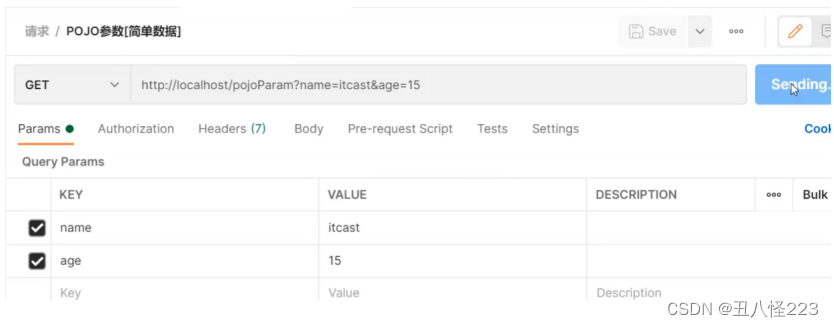
后台接收参数:
//POJO
参数:请求参数与形参对象中的属性对应即可完成参数传递
@RequestMapping
(
"/pojoParam"
)
@ResponseBody
public
String
pojoParam
(
User user
){
System
.
out
.
println
(
"pojo
参数传递
user ==> "
+
user
);
return
"{'module':'pojo param'}"
;
}
注意
:
- POJO参数接收,前端GET和POST发送请求数据的方式不变。
- 请求参数key的名称要和POJO中属性的名称一致,否则无法封装。
3. 嵌套POJO类型参数
如果
POJO
对象中嵌套了其他的
POJO
类,如
public class
Address
{
private
String
province
;
private
String
city
;
//setter...getter...
略
}
public class
User
{
private
String
name
;
private
int
age
;
private
Address address
;
//setter...getter...
略
}
- 嵌套POJO参数:请求参数名与形参对象属性名相同,按照对象层次结构关系即可接收嵌套POJO属 性参数
发送请求和参数
:
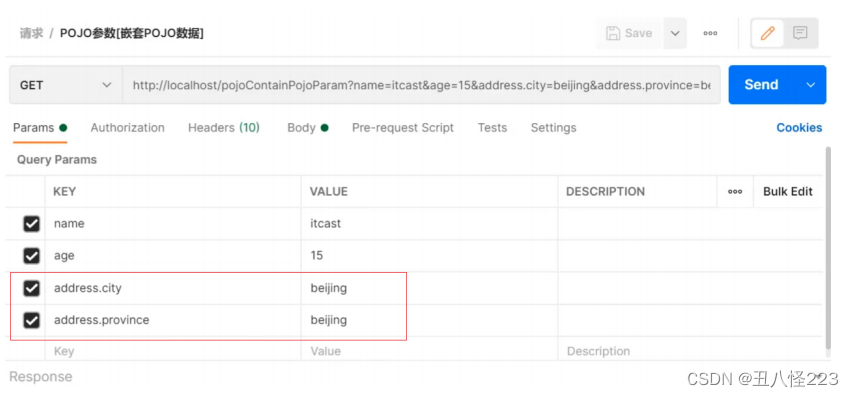
后台接收参数:
//POJO
参数:请求参数与形参对象中的属性对应即可完成参数传递
@RequestMapping
(
"/pojoParam"
)
@ResponseBody
public
String
pojoParam
(
User user
){
System
.
out
.
println
(
"pojo
参数传递
user ==> "
+
user
);
return
"{'module':'pojo param'}"
;
}
注意
:
请求参数
key
的名称要和
POJO
中属性的名称一致,否则无法封装
4. 数组类型参数
举个简单的例子,如果前端需要获取用户的爱好,爱好绝大多数情况下都是多个,如何发送请求数据 和接收数据呢?
- 数组参数:请求参数名与形参对象属性名相同且请求参数为多个,定义数组类型即可接收参数
发送请求和参数
:
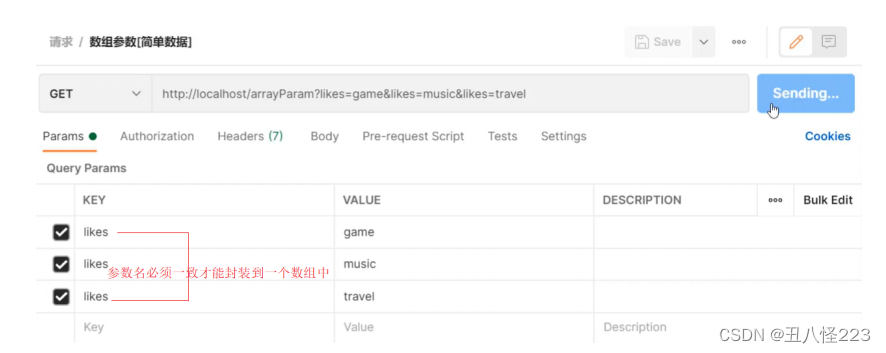
后台接收参数
:
//
数组参数:同名请求参数可以直接映射到对应名称的形参数组对象中
@RequestMapping
(
"/arrayParam"
)
@ResponseBody
public
String
arrayParam
(
String
[]
likes
){
System
.
out
.
println
(
"
数组参数传递
likes ==> "
+
Arrays
.
toString
(
likes
));
return
"{'module':'array param'}"
;
}
5. 集合类型参数
数组能接收多个值,那么集合是否也可以实现这个功能呢
?
发送请求和参数
:
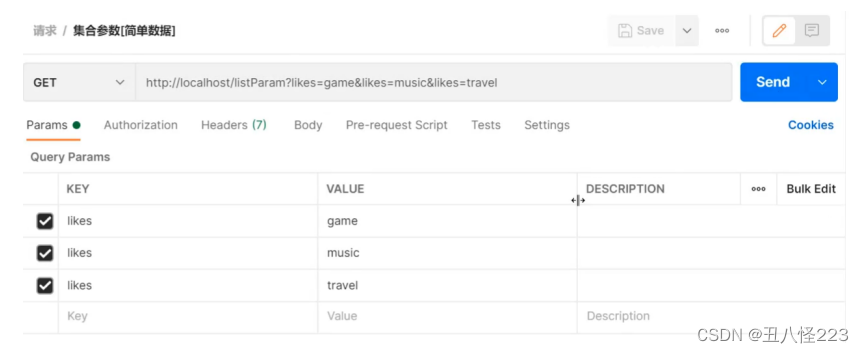
后台接收参数
:
//
集合参数:同名请求参数可以使用
@RequestParam
注解映射到对应名称的集合对象中作为数据
@RequestMapping
(
"/listParam"
)
@ResponseBody
public
String
listParam
(
List
<
String
>
likes
){
System
.
out
.
println
(
"
集合参数传递
likes ==> "
+
likes
);
return
"{'module':'list param'}"
;
}
运行会报错,

错误的原因是
:SpringMVC
将
List
看做是一个
POJO
对象来处理,将其创建一个对象并准备把前端的数 据封装到对象中,但是List
是一个接口无法创建对象,所以报错。
解决方案是
:
使用
@RequestParam
注解
//
集合参数:同名请求参数可以使用
@RequestParam
注解映射到对应名称的集合对象中作为数据
@RequestMapping
(
"/listParam"
)
@ResponseBody
public
String
listParam
(
List
<
String
>
likes
){
System
.
out
.
println
(
"
集合参数传递
likes ==> "
+
likes
);
return
"{'module':'list param'}"
;
}
- 集合保存普通参数:请求参数名与形参集合对象名相同且请求参数为多个,@RequestParam绑定 参数关系
- 对于简单数据类型使用数组会比集合更简单些。
知识点
1
:
@RequestParam

4.4 JSON数据传输参数
前面我们说过,现在比较流行的开发方式为异步调用。前后台以异步方式进行交换,传输的数据使用 的是
JSON
,
所以前端如果发送的是
JSON
数据,后端该如何接收
?
对于
JSON
数据类型,我们常见的有三种
:
- json普通数组(["value1","value2","value3",...])
- json对象({key1:value1,key2:value2,...})
- json对象数组([{key1:value1,...},{key2:value2,...}])
对于上述数据,前端如何发送,后端如何接收
?
JSON
普通数组
步骤
1:pom.xml
添加依赖
SpringMVC
默认使用的是
jackson
来处理
json
的转换,所以需要在
pom.xml
添加
jackson
依赖
<dependency>
<groupId>
com.fasterxml.jackson.core
</groupId>
<artifactId>
jackson-databind
</artifactId>
<version>
2.9.0
</version>
</dependency>
步骤
2:PostMan
发送
JSON
数据
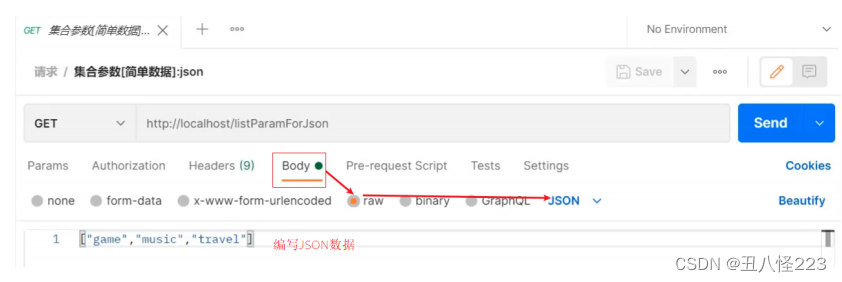
步骤
3:
开启
SpringMVC
注解支持
在
SpringMVC
的配置类中开启
SpringMVC
的注解支持,这里面就包含了将
JSON
转换成对象的功能。
@Configuration
@ComponentScan
(
"com.itheima.controller"
)
//
开启
json
数据类型自动转换
@EnableWebMvc
public class
SpringMvcConfig
{
}
步骤
4:
参数前添加
@RequestBody
//
使用
@RequestBody
注解将外部传递的
json
数组数据映射到形参的集合对象中作为数据
@RequestMapping
(
"/listParamForJson"
)
@ResponseBody
public
String
listParamForJson
(
@RequestBody
List
<
String
>
likes
){
System
.
out
.
println
(
"list common(json)
参数传递
list ==> "
+
likes
);
return
"{'module':'list common for json param'}"
;
}
步骤
5:
启动运行程序

JSON
普通数组的数据就已经传递完成,下面针对
JSON
对象数据和
JSON
对象数组的数据该如何传递呢
?
JSON
对象数据
我们会发现,只需要关注请求和数据如何发送
?
后端数据如何接收
?
请求和数据的发送
:
{
"name"
:
"itcast"
,
"age"
:
15
}

后端接收数据:
@RequestMapping
(
"/pojoParamForJson"
)
@ResponseBody
public
String
pojoParamForJson
(
@RequestBody
User user
){
System
.
out
.
println
(
"pojo(json)
参数传递
user ==> "
+
user
);
return
"{'module':'pojo for json param'}"
;
}
启动程序访问测试

说明
:
address
为
null
的原因是前端没有传递数据给后端。
如果想要
address
也有数据,我们需求修改前端传递的数据内容
:
{
"name"
:
"itcast"
,
"age"
:
15
,
"address"
:{
"province"
:
"beijing"
,
"city"
:
"beijing"
}
}
再次发送请求,就能看到
address
中的数据

JSON
对象数组
集合中保存多个
POJO
该如何实现
?
请求和数据的发送
:
[
{
"name"
:
"itcast"
,
"age"
:
15
},
{
"name"
:
"itheima"
,
"age"
:
12
}
]

后端接收数据
:
@RequestMapping
(
"/listPojoParamForJson"
)
@ResponseBody
public
String
listPojoParamForJson
(
@RequestBody
List
<
User
>
list
){
System
.
out
.
println
(
"list pojo(json)
参数传递
list ==> "
+
list
);
return
"{'module':'list pojo for json param'}"
;
}
启动程序访问测试

小结
SpringMVC
接收
JSON
数据的实现步骤为
:
(1)
导入
jackson
包
(2)
使用
PostMan
发送
JSON
数据
(3)
开启
SpringMVC
注解驱动,在配置类上添加
@EnableWebMvc
注解
(4)Controller
方法的参数前添加
@RequestBody
注解
知识点
1
:
@EnableWebMvc

知识点
2
:
@RequestBody

@RequestBody
与
@RequestParam
区别
- 区别
@RequestParam
用于接收
url
地址传参,表单传参【
application/x-www-form
urlencoded
】
@RequestBody
用于接收
json
数据【
application/json
】
- 应用
后期开发中,发送
json
格式数据为主,
@RequestBody
应用较广
如果发送非
json
格式数据,选用
@RequestParam
接收请求参数
4.5 日期类型参数传递
前面我们处理过简单数据类型、
POJO
数据类型、数组和集合数据类型以及
JSON
数据类型,接下来我们
还得处理一种开发中比较常见的一种数据类型,
日期类型
日期类型比较特殊,因为对于日期的格式有
N
多中输入方式,比如
:
- 2088-08-18
- 2088/08/18
- 08/18/2088
- ......
针对这么多日期格式,
SpringMVC
该如何接收,它能很好的处理日期类型数据么
?
步骤
1:
编写方法接收日期数据
在
UserController
类中添加方法,把参数设置为日期类型
@RequestMapping
(
"/dataParam"
)
@ResponseBody
public
String
dataParam
(
Date date
)
System
.
out
.
println
(
"
参数传递
date ==> "
+
date
);
return
"{'module':'data param'}"
;
}
步骤
2:
启动
Tomcat
服务器
查看控制台是否报错,如果有错误,先解决错误。
步骤
3:
使用
PostMan
发送请求
使用
PostMan
发送
GET
请求,并设置
date
参数
http://localhost/dataParam?date=2088/08/08
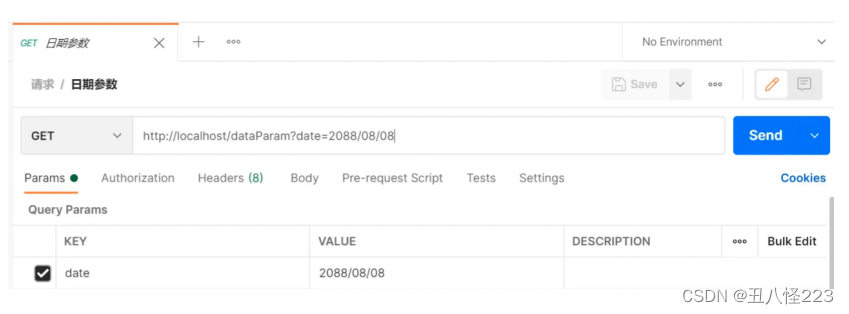
步骤
4:
查看控制台

通过打印,我们发现
SpringMVC
可以接收日期数据类型,并将其打印在控制台。
这个时候,我们就想如果把日期参数的格式改成其他的,
SpringMVC
还能处理么
?
步骤
5:
更换日期格式
为了能更好的看到程序运行的结果,我们在方法中多添加一个日期参数
@RequestMapping
(
"/dataParam"
)
@ResponseBody
public
String
dataParam
(
Date date
,
Date date1
)
System
.
out
.
println
(
"
参数传递
date ==> "
+
date
);
return
"{'module':'data param'}"
;
}
使用
PostMan
发送请求,携带两个不同的日期格式,
http://localhost/dataParam?date=2088/08/08&date1=2088
-
08
-
08
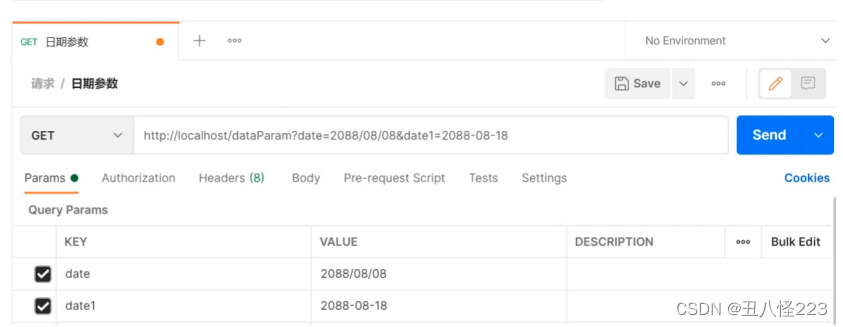
发送请求和数据后,页面会报
400
,控制台会报出一个错误
Resolved
[org.springframework.web.method.annotation.
MethodArgumentTypeMismatchExcep
tion
: Failed to convert value of type 'java.lang.String' to required type
'java.util.Date'; nested exception is
org.springframework.core.convert.
ConversionFailedException
: Failed to
convert from type [java.lang.String] to type [java.util.Date] for value
'2088-08-08'; nested exception is java.lang.IllegalArgumentException]
从错误信息可以看出,错误的原因是在将
2088
-
08
-
08
转换成日期类型的时候失败了,原因是
SpringMVC
默认支持的字符串转日期的格式为
yyyy/MM/dd
,
而我们现在传递的不符合其默认格式,
SpringMVC
就无法进行格式转换,所以报错。
解决方案也比较简单,需要使用
@DateTimeFormat
@RequestMapping
(
"/dataParam"
)
@ResponseBody
public
String
dataParam
(
Date date
,
@DateTimeFormat
(
pattern
=
"yyyy-MM-dd"
)
Date date1
)
System
.
out
.
println
(
"
参数传递
date ==> "
+
date
);
System
.
out
.
println
(
"
参数传递
date1(yyyy-MM-dd) ==> "
+
date1
);
return
"{'module':'data param'}"
;
}
重新启动服务器,重新发送请求测试,
SpringMVC
就可以正确的进行日期转换了

步骤
6:
携带时间的日期
接下来我们再来发送一个携带时间的日期,看下
SpringMVC
该如何处理
?
先修改
UserController
类,添加第三个参数
@RequestMapping
(
"/dataParam"
)
@ResponseBody
public
String
dataParam
(
Date date
,
@DateTimeFormat
(
pattern
=
"yyyy-MM-dd"
)
Date date1
,
@DateTimeFormat
(
pattern
=
"yyyy/MM/dd HH:mm:ss"
)
Date
date2
)
System
.
out
.
println
(
"
参数传递
date ==> "
+
date
);
System
.
out
.
println
(
"
参数传递
date1(yyyy-MM-dd) ==> "
+
date1
);
System
.
out
.
println
(
"
参数传递
date2(yyyy/MM/dd HH:mm:ss) ==> "
+
date2
);
return
"{'module':'data param'}"
;
}
使用
PostMan
发送请求,携带两个不同的日期格式,
http://localhost/dataParam?date=2088/08/08&date1=2088
-
08
-
08&date2=2088/08/08
8:08:08

重新启动服务器,重新发送请求测试,
SpringMVC
就可以将日期时间的数据进行转换

知识点
1
:
@DateTimeFormat
内部实现原理
讲解内部原理之前,我们需要先思考个问题
:
- 前端传递字符串,后端使用日期Date接收
- 前端传递JSON数据,后端使用对象接收
- 前端传递字符串,后端使用Integer接收
- 后台需要的数据类型有很多中
- 在数据的传递过程中存在很多类型的转换
问
:
谁来做这个类型转换
?
答
:SpringMVC
问
:SpringMVC
是如何实现类型转换的
?
答
:SpringMVC
中提供了很多类型转换接口和实现类
在框架中,有一些类型转换接口,其中有
:
(1) Converter
接口
/**
* S: the source type
* T: the target type
*/
public interface
Converter
<
S
,
T
>
{
@Nullable
//
该方法就是将从页面上接收的数据
(S)
转换成我们想要的数据类型
(T)
返回
T convert
(
S source
);
}
注意
:Converter
所属的包为
org.springframework.core.convert.converter
Converter
接口的实现类

框架中有提供很多对应
Converter
接口的实现类,用来实现不同数据类型之间的转换
,
如
:
请求参数年龄数据(
String→Integer
)
日期格式转换(
String → Date
)
- (2) HttpMessageConverter接口
该接口是实现对象与
JSON
之间的转换工作
注意
:SpringMVC
的配置类把
@EnableWebMvc
当做标配配置上去,不要省略
4.6 响应
SpringMVC
接收到请求和数据后,进行一些了的处理,当然这个处理可以是转发给
Service
,
Service
层再调用
Dao
层完成的,不管怎样,处理完以后,都需要将结果告知给用户。
比如
:
根据用户
ID
查询用户信息、查询用户列表、新增用户等。
对于响应,主要就包含两部分内容:
- 响应页面
- 响应数据
文本数据
json
数据
因为异步调用是目前常用的主流方式,所以我们需要更关注的就是如何返回
JSON
数据,对于其他只需 要认识了解即可。
1. 环境准备
- 创建一个Web的Maven项目
- pom.xml添加Spring依赖
<?xml version="1.0" encoding="UTF-8"?>
<project
xmlns
=
"http://maven.apache.org/POM/4.0.0"
xmlns:xsi
=
"http://www.w3.org/2001/XMLSchema-instance"
xsi:schemaLocation
=
"http://maven.apache.org/POM/4.0.0
http://maven.apache.org/xsd/maven-4.0.0.xsd"
>
<modelVersion>
4.0.0
</modelVersion>
<groupId>
com.itheima
</groupId>
<artifactId>
springmvc_05_response
</artifactId>
<version>
1.0-SNAPSHOT
</version>
<packaging>
war
</packaging>
<dependencies>
<dependency>
<groupId>
javax.servlet
</groupId>
<artifactId>
javax.servlet-api
</artifactId>
<version>
3.1.0
</version>
<scope>
provided
</scope>
</dependency>
<dependency>
<groupId>
org.springframework
</groupId>
<artifactId>
spring-webmvc
</artifactId>
<version>
5.2.10.RELEASE
</version>
</dependency>
<dependency>
<groupId>
com.fasterxml.jackson.core
</groupId>
<artifactId>
jackson-databind
</artifactId>
<version>
2.9.0
</version>
</dependency>
</dependencies>
<build>
<plugins>
<plugin>
34
<groupId>
org.apache.tomcat.maven
</groupId>
35
<artifactId>
tomcat7-maven-plugin
</artifactId>
36
<version>
2.1
</version>
37
<configuration>
38
<port>
80
</port>
39
<path>
/
</path>
40
</configuration>
41
</plugin>
42
</plugins>
43
</build>
44
</project>
45
- 创建对应的配置类
1
public class
ServletContainersInitConfig
extends
AbstractAnnotationConfigDispatcherServletInitializer
{
2
protected
Class
<?>
[]
getRootConfigClasses
() {
3
return new
Class
[
0
];
4
}
5
6
protected
Class
<?>
[]
getServletConfigClasses
() {
7
return new
Class
[]{
SpringMvcConfig
.
class
};
8
}
9
10
protected
String
[]
getServletMappings
() {
11
return new
String
[]{
"/"
};
12
}
13
14
//
乱码处理
15
@Override
16
protected
Filter
[]
getServletFilters
() {
17
CharacterEncodingFilter filter
=
new
CharacterEncodingFilter
();
18
filter
.
setEncoding
(
"UTF-8"
);
19
return new
Filter
[]{
filter
};
20
}
21
}
22
23
@Configuration
24
@ComponentScan
(
"com.itheima.controller"
)
25
//
开启
json
数据类型自动转换
26
@EnableWebMvc
27
public class
SpringMvcConfig
{
28
}
29
30
- 编写模型类User
public class
User
{
private
String
name
;
private
int
age
;
//getter...setter...toString
省略
}
- webapp下创建page.jsp
<html>
<body>
<h2>
Hello Spring MVC!
</h2>
</body>
</html>
- 编写UserController
@Controller
public class
UserController
{
}
最终创建好的项目结构如下
:
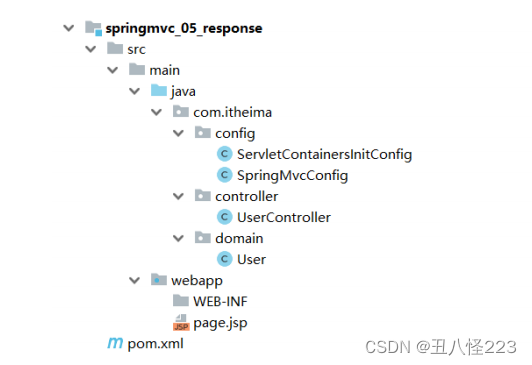
2. 响应页面[了解]
步骤
1:
设置返回页面
@Controller
public class
UserController
{
@RequestMapping
(
"/toJumpPage"
)
//
注意
//1.
此处不能添加
@ResponseBody,
如果加了该注入,会直接将
page.jsp
当字符串返回前端
//2.
方法需要返回
String
public
String
toJumpPage
(){
System
.
out
.
println
(
"
跳转页面
"
);
return
"page.jsp"
;
}
}
步骤
2:
启动程序测试
此处涉及到页面跳转,所以不适合采用
PostMan
进行测试,直接打开浏览器,输入
http://localhost/toJumpPage
3. 返回文本数据[了解]
步骤
1:
设置返回文本内容
@Controller
public class
UserController
{
@RequestMapping
(
"/toText"
)
//
注意此处该注解就不能省略,如果省略了
,
会把
response text
当前页面名称去查找,如果没有
回报
404
错误
@ResponseBody
public
String
toText
(){
System
.
out
.
println
(
"
返回纯文本数据
"
);
return
"response text"
;
}
}
步骤
2:
启动程序测试
此处不涉及到页面跳转,因为我们现在发送的是
GET
请求,可以使用浏览器也可以使用
PostMan
进行 测试,输入地址http://localhost/toText
访问
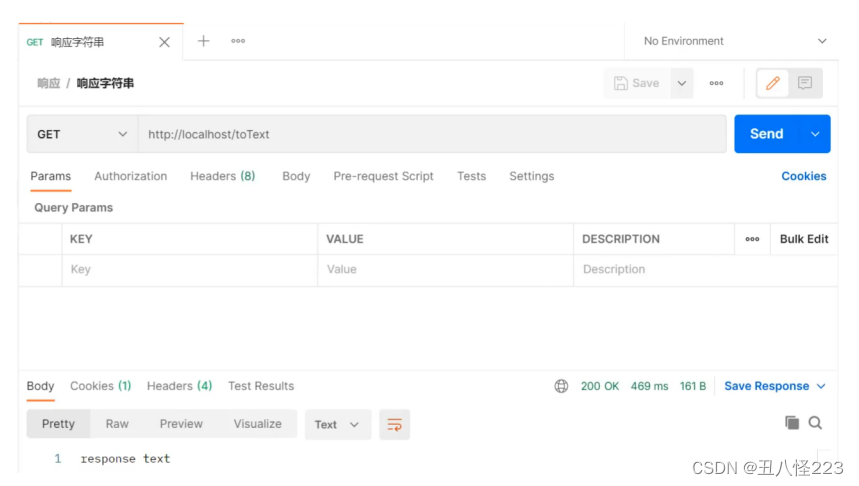
4 . 响应JSON数据
响应
POJO
对象
@Controller
public class
UserController
{
@RequestMapping
(
"/toJsonPOJO"
)
@ResponseBody
public
User toJsonPOJO
(){
System
.
out
.
println
(
"
返回
json
对象数据
"
);
User user
=
new
User
();
user
.
setName
(
"itcast"
);
user
.
setAge
(
15
);
return
user
;
}
}
返回值为实体类对象,设置返回值为实体类类型,即可实现返回对应对象的
json
数据,需要依赖
@ResponseBody
注解和
@EnableWebMvc
注解
重新启动服务器,访问
http://localhost/toJsonPOJO
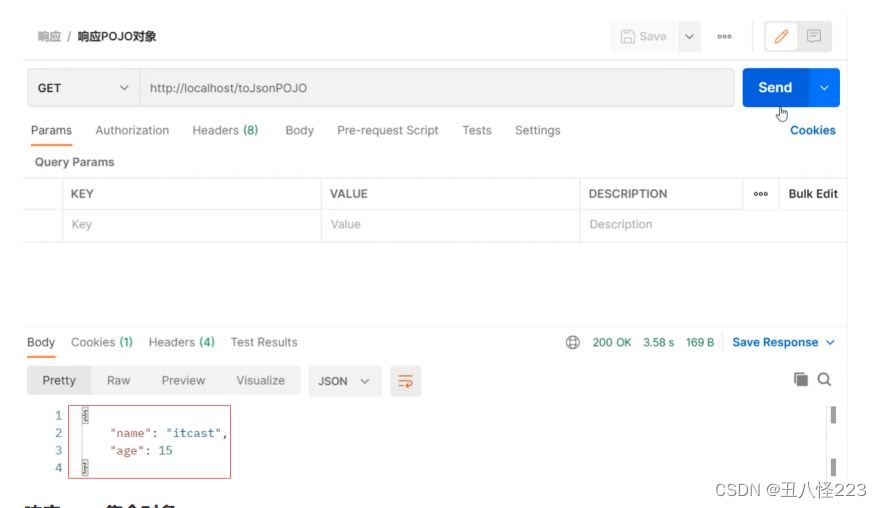
响应
POJO
集合对象
@Controller
public class
UserController
{
@RequestMapping
(
"/toJsonList"
)
@ResponseBody
public
List
<
User
>
toJsonList
(){
System
.
out
.
println
(
"
返回
json
集合数据
"
);
User user1
=
new
User
();
user1
.
setName
(
"
传智播客
"
);
user1
.
setAge
(
15
);
User user2
=
new
User
();
user2
.
setName
(
"
黑马程序员
"
);
user2
.
setAge
(
12
);
List
<
User
>
userList
=
new
ArrayList
<
User
>
();
userList
.
add
(
user1
);
userList
.
add
(
user2
);
return
userList
;
}
}
重新启动服务器,访问
http://localhost/toJsonList
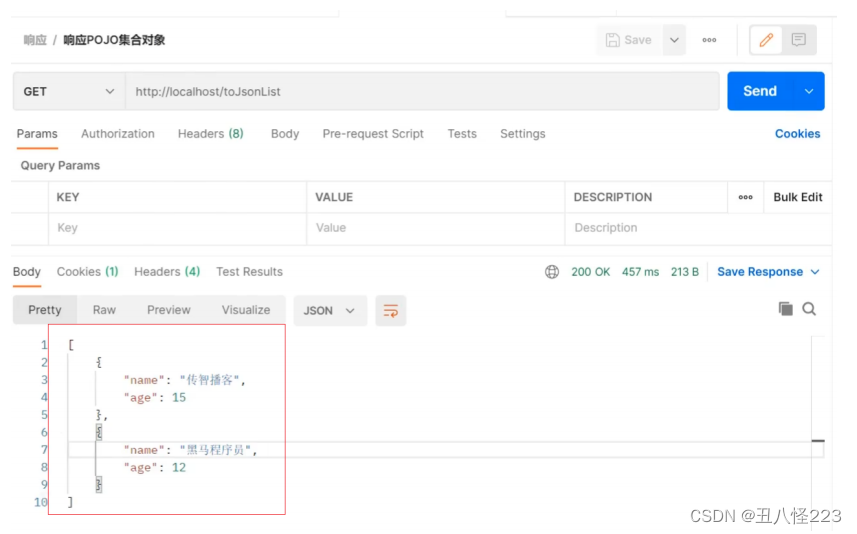
知识点
1
:
@ResponseBody

说明
:
- 该注解可以写在类上或者方法上
- 写在类上就是该类下的所有方法都有@ReponseBody功能
- 当方法上有@ReponseBody注解后
方法的返回值为字符串,会将其作为文本内容直接响应给前端
方法的返回值为对象,会将对象转换成
JSON
响应给前端
此处又使用到了类型转换,内部还是通过
Converter
接口的实现类完成的,所以
Converter
除了前面
所说的功能外,它还可以实现
:
- 对象转Json数据(POJO -> json)
- 集合转Json数据(Collection -> json)
五、Rest风格
对于
Rest
风格,我们需要学习的内容包括
:
- REST简介
- REST入门案例
- REST快速开发
- 案例:基于RESTful页面数据交互
5.1 REST简介
REST
(
Representational State Transfer
),表现形式状态转换
,
它是一种软件架构
风格
当我们想表示一个网络资源的时候,可以使用两种方式
:
- 传统风格资源描述形式
http://localhost/user/getById?id=1
查询
id
为
1
的用户信息
http://localhost/user/saveUser
保存用户信息
- REST风格描述形式
http://localhost/user/1
http://localhost/user
传统方式一般是一个请求
url
对应一种操作,这样做不仅麻烦,也不安全,因为会程序的人读取了你的 请求url
地址,就大概知道该
url
实现的是一个什么样的操作。
查看
REST
风格的描述,你会发现请求地址变的简单了,并且光看请求
URL
并不是很能猜出来该
URL
的 具体功能
所以
REST
的优点有
:
- 隐藏资源的访问行为,无法通过地址得知对资源是何种操作
- 书写简化
但是我们的问题也随之而来了,一个相同的
url
地址即可以是新增也可以是修改或者查询,那么到底我 们该如何区分该请求到底是什么操作呢?
- 按照REST风格访问资源时使用行为动作区分对资源进行了何种操作
http://localhost/users
查询全部用户信息
GET
(查询)
http://localhost/users/1
查询指定用户信息
GET
(查询)
http://localhost/users
添加用户信息
POST
(新增
/
保存)
http://localhost/users
修改用户信息
PUT
(修改
/
更新)
http://localhost/users/1
删除用户信息
DELETE
(删除)
请求的方式比较多,但是比较常用的就
4
种,分别是
GET
,
POST
,
PUT
,
DELETE
。
按照不同的请求方式代表不同的操作类型。
- 发送GET请求是用来做查询
- 发送POST请求是用来做新增
- 发送PUT请求是用来做修改
- 发送DELETE请求是用来做删除
但是
注意
:
- 上述行为是约定方式,约定不是规范,可以打破,所以称REST风格,而不是REST规范
REST
提供了对应的架构方式,按照这种架构设计项目可以降低开发的复杂性,提高系统的可伸
缩性
REST
中规定
GET/POST/PUT/DELETE
针对的是查询
/
新增
/
修改
/
删除,但是我们如果非要用
GET
请求做删除,这点在程序上运行是可以实现的
但是如果绝大多数人都遵循这种风格,你写的代码让别人读起来就有点莫名其妙了。
- 描述模块的名称通常使用复数,也就是加s的格式描述,表示此类资源,而非单个资源,例 如:users、books、accounts......
清楚了什么是
REST
风格后,我们后期会经常提到一个概念叫
RESTful
,那什么又是
RESTful
呢
?
- 根据REST风格对资源进行访问称为RESTful。
后期我们在进行开发的过程中,大多是都是遵从
REST
风格来访问我们的后台服务,所以可以说咱们以 后都是基于RESTful
来进行开发的。
5.2 RESTful入门案例
1. 环境准备
- 创建一个Web的Maven项目
- pom.xml添加Spring依赖
<?xml version="1.0" encoding="UTF-8"?>
<project
xmlns
=
"http://maven.apache.org/POM/4.0.0"
xmlns:xsi
=
"http://www.w3.org/2001/XMLSchema-instance"
xsi:schemaLocation
=
"http://maven.apache.org/POM/4.0.0
http://maven.apache.org/xsd/maven-4.0.0.xsd"
>
<modelVersion>
4.0.0
</modelVersion>
<groupId>
com.itheima
</groupId>
<artifactId>
springmvc_06_rest
</artifactId>
<version>
1.0-SNAPSHOT
</version>
<packaging>
war
</packaging>
<dependencies>
<dependency>
<groupId>
javax.servlet
</groupId>
<artifactId>
javax.servlet-api
</artifactId>
<version>
3.1.0
</version>
<scope>
provided
</scope>
</dependency>
19
<dependency>
20
<groupId>
org.springframework
</groupId>
21
<artifactId>
spring-webmvc
</artifactId>
22
<version>
5.2.10.RELEASE
</version>
23
</dependency>
24
<dependency>
25
<groupId>
com.fasterxml.jackson.core
</groupId>
26
<artifactId>
jackson-databind
</artifactId>
27
<version>
2.9.0
</version>
28
</dependency>
29
</dependencies>
30
31
<build>
32
<plugins>
33
<plugin>
34
<groupId>
org.apache.tomcat.maven
</groupId>
35
<artifactId>
tomcat7-maven-plugin
</artifactId>
36
<version>
2.1
</version>
37
<configuration>
38
<port>
80
</port>
39
<path>
/
</path>
40
</configuration>
41
</plugin>
42
</plugins>
43
</build>
44
</project>
45
- 创建对应的配置类
1
public class
ServletContainersInitConfig
extends
AbstractAnnotationConfigDispatcherServletInitializer
{
2
protected
Class
<?>
[]
getRootConfigClasses
() {
3
return new
Class
[
0
];
4
}
5
6
protected
Class
<?>
[]
getServletConfigClasses
() {
7
return new
Class
[]{
SpringMvcConfig
.
class
};
8
}
9
10
protected
String
[]
getServletMappings
() {
11
return new
String
[]{
"/"
};
12
}
13
14
//
乱码处理
15
@Override
16
protected
Filter
[]
getServletFilters
() {
17
CharacterEncodingFilter filter
=
new
CharacterEncodingFilter
();
18
filter
.
setEncoding
(
"UTF-8"
);
19
return new
Filter
[]{
filter
};
20
}
21
}
22
23
@Configuration
24
@ComponentScan
(
"com.itheima.controller"
)
25
//
开启
json
数据类型自动转换
26
@EnableWebMvc
27
public class
SpringMvcConfig
{
28
}
29
30
- 编写模型类User和Book
1
public class
User
{
2
private
String
name
;
3
private
int
age
;
4
//getter...setter...toString
省略
5
}
6
7
public class
Book
{
8
private
String
name
;
9
private
double
price
;
10
//getter...setter...toString
省略
11
}
- 编写UserController和BookController
1
@Controller
2
public class
UserController
{
3
@RequestMapping
(
"/save"
)
4
@ResponseBody
5
public
String
save
(
@RequestBody
User user
) {
6
System
.
out
.
println
(
"user save..."
+
user
);
7
return
"{'module':'user save'}"
;
8
}
9
10
@RequestMapping
(
"/delete"
)
11
@ResponseBody
12
public
String
delete
(
Integer
id
) {
13
System
.
out
.
println
(
"user delete..."
+
id
);
14
return
"{'module':'user delete'}"
;
15
}
16
17
@RequestMapping
(
"/update"
)
18
@ResponseBody
19
public
String
update
(
@RequestBody
User user
) {
20
System
.
out
.
println
(
"user update..."
+
user
);
21
return
"{'module':'user update'}"
;
22
}
23
24
@RequestMapping
(
"/getById"
)
25
@ResponseBody
26
public
String
getById
(
Integer
id
) {
27
System
.
out
.
println
(
"user getById..."
+
id
);
28
return
"{'module':'user getById'}"
;
29
}
30
31
@RequestMapping
(
"/findAll"
)
32
@ResponseBody
33
public
String
getAll
() {
34
System
.
out
.
println
(
"user getAll..."
);
35
return
"{'module':'user getAll'}"
;
36
}
37
}
38
39
40
@Controller
41
public class
BookController
{
42
43
@RequestMapping
(
value
=
"/books"
,
method
=
RequestMethod
.
POST
)
44
@ResponseBody
45
public
String
save
(
@RequestBody
Book book
){
46
System
.
out
.
println
(
"book save..."
+
book
);
47
return
"{'module':'book save'}"
;
48
}
49
50
@RequestMapping
(
value
=
"/books/{id}"
,
method
=
RequestMethod
.
DELETE
)
51
@ResponseBody
52
public
String
delete
(
@PathVariable
Integer
id
){
53
System
.
out
.
println
(
"book delete..."
+
id
);
54
return
"{'module':'book delete'}"
;
55
}
56
57
@RequestMapping
(
value
=
"/books"
,
method
=
RequestMethod
.
PUT
)
58
@ResponseBody
59
public
String
update
(
@RequestBody
Book book
){
60
System
.
out
.
println
(
"book update..."
+
book
);
61
return
"{'module':'book update'}"
;
62
}
63
64
@RequestMapping
(
value
=
"/books/{id}"
,
method
=
RequestMethod
.
GET
)
65
@ResponseBody
最终创建好的项目结构如下
:
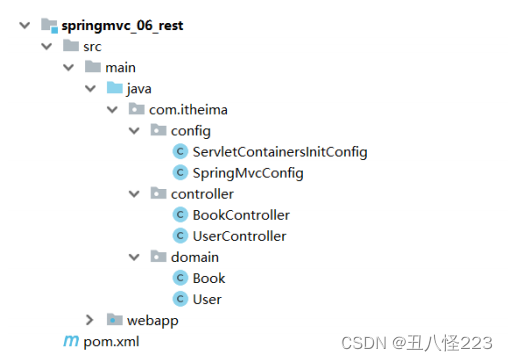
2. 思路分析
需求
:
将之前的增删改查替换成
RESTful
的开发方式。
1.
之前不同的请求有不同的路径
,
现在要将其修改为统一的请求路径
修改前
:
新增
: /save ,
修改
: /update,
删除
/delete...
修改后
:
增删改查
: /users
2.
根据
GET
查询、
POST
新增、
PUT
修改、
DELETE
删除对方法的请求方式进行限定
3.
发送请求的过程中如何设置请求参数
?
3. 修改RESTful风格
新增
public
String
getById
(
@PathVariable
Integer
id
){
System
.
out
.
println
(
"book getById..."
+
id
);
return
"{'module':'book getById'}"
;
}
@RequestMapping
(
value
=
"/books"
,
method
=
RequestMethod
.
GET
)
@ResponseBody
public
String
getAll
(){
System
.
out
.
println
(
"book getAll..."
);
return
"{'module':'book getAll'}"
;
}
}
- 将请求路径更改为/users
访问该方法使用
POST:
http://localhost/users
- 使用method属性限定该方法的访问方式为POST
如果发送的不是
POST
请求,比如发送
GET
请求,则会报错

删除
@Controller
public class
UserController
{
//
设置当前请求方法为
POST
,表示
REST
风格中的添加操作
@RequestMapping
(
value
=
"/users"
,
method
=
RequestMethod
.
POST
)
@ResponseBody
public
String
save
() {
System
.
out
.
println
(
"user save..."
);
return
"{'module':'user save'}"
;
}
}
- 将请求路径更改为/users
访问该方法使用
DELETE:
http://localhost/users
访问成功,但是删除方法没有携带所要删除数据的
id,
所以针对
RESTful
的开发,如何携带数据参数
?
传递路径参数
前端发送请求的时候使用
:
http://localhost/users/1
,
路径中的
1
就是我们想要传递的参数。
后端获取参数,需要做如下修改
:
- 修改@RequestMapping的value属性,将其中修改为/users/{id},目的是和路径匹配
- 在方法的形参前添加@PathVariable注解
@Controller
public class
UserController
{
//
设置当前请求方法为
DELETE
,表示
REST
风格中的删除操作
@RequestMapping
(
value
=
"/users"
,
method
=
RequestMethod
.
DELETE
)
@ResponseBody
public
String
delete
(
Integer
id
) {
System
.
out
.
println
(
"user delete..."
+
id
);
return
"{'module':'user delete'}"
;
}
}
思考如下两个问题
:
(1)
如果方法形参的名称和路径
{}
中的值不一致,该怎么办
?
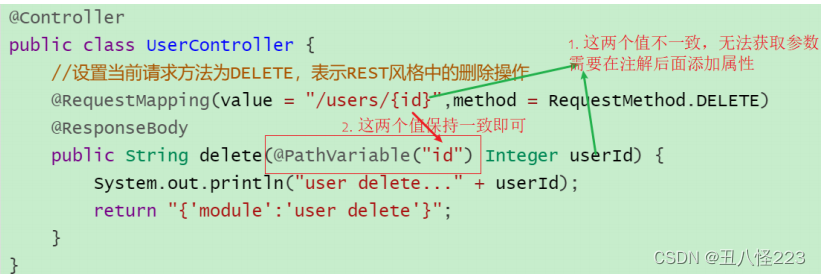
(2)
如果有多个参数需要传递该如何编写
?
前端发送请求的时候使用
:
http://localhost/users/1/tom
,
路径中的
1
和
tom
就是我们想要传递的
两个参数。
后端获取参数,需要做如下修改
:
@Controller
public class
UserController
{
//
设置当前请求方法为
DELETE
,表示
REST
风格中的删除操作
@RequestMapping
(
value
=
"/users/{id}"
,
method
=
RequestMethod
.
DELETE
)
@ResponseBody
public
String
delete
(
@PathVariable
Integer
id
) {
System
.
out
.
println
(
"user delete..."
+
id
);
return
"{'module':'user delete'}"
;
}
}
修改
@Controller
public class
UserController
{
//
设置当前请求方法为
DELETE
,表示
REST
风格中的删除操作
@RequestMapping
(
value
=
"/users/{id}/{name}"
,
method
=
RequestMethod
.
DELETE
)
@ResponseBody
public
String
delete
(
@PathVariable
Integer
id
,
@PathVariable
String
name
)
{
System
.
out
.
println
(
"user delete..."
+
id
+
","
+
name
);
return
"{'module':'user delete'}"
;
}
}
- 将请求路径更改为/users
访问该方法使用
PUT:
http://localhost/users
- 访问并携带参数:

根据
ID
查询
@Controller
public class
UserController
{
//
设置当前请求方法为
GET
,表示
REST
风格中的查询操作
@RequestMapping
(
value
=
"/users/{id}"
,
method
=
RequestMethod
.
GET
)
@ResponseBody
public
String
getById
(
@PathVariable
Integer
id
){
System
.
out
.
println
(
"user getById..."
+
id
);
return
"{'module':'user getById'}"
;
}
}
将请求路径更改为
/users
- 访问该方法使用 GET: http://localhost/users/666
查询所有
@Controller
public class
UserController
{
//
设置当前请求方法为
GET
,表示
REST
风格中的查询操作
@RequestMapping
(
value
=
"/users"
,
method
=
RequestMethod
.
GET
)
@ResponseBody
public
String
getAll
() {
System
.
out
.
println
(
"user getAll..."
);
return
"{'module':'user getAll'}"
;
}
}
将请求路径更改为
/users
- 访问该方法使用 GET: http://localhost/users
小结
RESTful
入门案例,我们需要学习的内容如下
:
(1)
设定
Http
请求动作
(
动词
)
@RequestMapping(value="",
method
= RequestMethod.
POST|GET|PUT|DELETE
)
(2)
设定请求参数
(
路径变量
)
@RequestMapping(value="/users/
{id}
",method = RequestMethod.DELETE)
@ReponseBody
public String delete(
@PathVariable
Integer
id
){
}
知识点
1
:
@PathVariable

关于接收参数,我们学过三个注解
@RequestBody
、
@RequestParam
、
@PathVariable
,
这三个注解
之间的区别和应用分别是什么
?
- 区别
@RequestParam
用于接收
url
地址传参或表单传参
@RequestBody
用于接收
json
数据
@PathVariable
用于接收路径参数,使用
{
参数名称
}
描述路径参数
- 应用
后期开发中,发送请求参数超过
1
个时,以
json
格式为主,
@RequestBody
应用较广
如果发送非
json
格式数据,选用
@RequestParam
接收请求参数
采用
RESTful
进行开发,当参数数量较少时,例如
1
个,可以采用
@PathVariable
接收请求路
径变量,通常用于传递
id
值
5.3 RESTful快速开发
做完了
RESTful
的开发,你会发现
好麻烦
,麻烦在哪
?
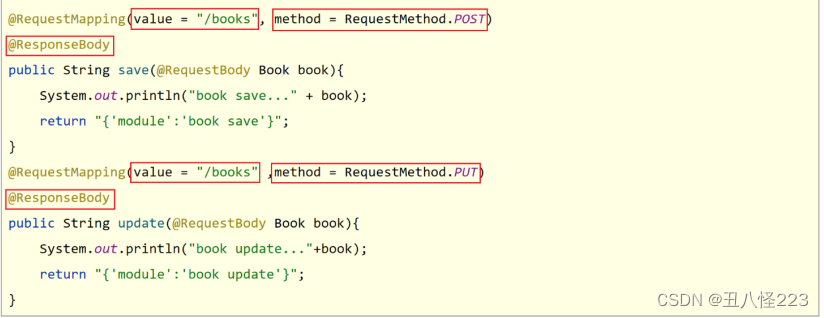
问题
1
:每个方法的
@RequestMapping
注解中都定义了访问路径
/books
,重复性太高。
问题
2
:每个方法的
@RequestMapping
注解中都要使用
method
属性定义请求方式,重复性太高。
问题
3
:每个方法响应
json
都需要加上
@ResponseBody
注解,重复性太高。
对于上面所提的这三个问题,具体该如何解决
?
@RestController
//@Controller + ReponseBody
@RequestMapping
(
"/books"
)
public class
BookController
{
//@RequestMapping(method = RequestMethod.POST)
@PostMapping
public
String
save
(
@RequestBody
Book book
){
System
.
out
.
println
(
"book save..."
+
book
);
return
"{'module':'book save'}"
;
}
//@RequestMapping(value = "/{id}",method = RequestMethod.DELETE)
@DeleteMapping
(
"/{id}"
)
public
String
delete
(
@PathVariable
Integer
id
){
System
.
out
.
println
(
"book delete..."
+
id
);
return
"{'module':'book delete'}"
;
}
//@RequestMapping(method = RequestMethod.PUT)
@PutMapping
public
String
update
(
@RequestBody
Book book
){
System
.
out
.
println
(
"book update..."
+
book
);
return
"{'module':'book update'}"
;
}
//@RequestMapping(value = "/{id}",method = RequestMethod.GET)
@GetMapping
(
"/{id}"
)
public
String
getById
(
@PathVariable
Integer
id
){
System
.
out
.
println
(
"book getById..."
+
id
);
return
"{'module':'book getById'}"
;
}
//@RequestMapping(method = RequestMethod.GET)
@GetMapping
public
String
getAll
(){
System
.
out
.
println
(
"book getAll..."
);
return
"{'module':'book getAll'}"
;
}
}
对于刚才的问题,我们都有对应的解决方案:
问题
1
:每个方法的
@RequestMapping
注解中都定义了访问路径
/books
,重复性太高。
将
@RequestMapping
提到类上面,用来定义所有方法共同的访问路径。
问题
2
:每个方法的
@RequestMapping
注解中都要使用
method
属性定义请求方式,重复性太高。
使用
@GetMapping @PostMapping @PutMapping @DeleteMapping
代替
问题
3
:每个方法响应
json
都需要加上
@ResponseBody
注解,重复性太高。
1.
将
ResponseBody
提到类上面,让所有的方法都有
@ResponseBody
的功能
2.
使用
@RestController
注解替换
@Controller
与
@ResponseBody
注解,简化书写
知识点
1
:
@RestController

知识点
2
:
@GetMapping @PostMapping @PutMapping @DeleteMapping

5.4 RESTful案例
1. 需求分析
需求一
:
图片列表查询,从后台返回数据,将数据展示在页面上

需求二
:
新增图片,将新增图书的数据传递到后台,并在控制台打印

说明
:
此次案例的重点是在
SpringMVC
中如何使用
RESTful
实现前后台交互,所以本案例并没有和数 据库进行交互,所有数据使用假
数据来完成开发。
步骤分析
:
1.
搭建项目导入
jar
包
2.
编写
Controller
类,提供两个方法,一个用来做列表查询,一个用来做新增
3.
在方法上使用
RESTful
进行路径设置
4.
完成请求、参数的接收和结果的响应
5.
使用
PostMan
进行测试
6.
将前端页面拷贝到项目中
7.
页面发送
ajax
请求
8.
完成页面数据的展示
2. 环境准备
- 创建一个Web的Maven项目
- pom.xml添加Spring依赖
<?xml version="1.0" encoding="UTF-8"?>
<project
xmlns
=
"http://maven.apache.org/POM/4.0.0"
xmlns:xsi
=
"http://www.w3.org/2001/XMLSchema-instance"
xsi:schemaLocation
=
"http://maven.apache.org/POM/4.0.0
http://maven.apache.org/xsd/maven-4.0.0.xsd"
>
<modelVersion>
4.0.0
</modelVersion>
<groupId>
com.itheima
</groupId>
<artifactId>
springmvc_07_rest_case
</artifactId>
<version>
1.0-SNAPSHOT
</version>
<packaging>
war
</packaging>
<dependencies>
<dependency>
<groupId>
javax.servlet
</groupId>
<artifactId>
javax.servlet-api
</artifactId>
<version>
3.1.0
</version>
<scope>
provided
</scope>
</dependency>
<dependency>
<groupId>
org.springframework
</groupId>
<artifactId>
spring-webmvc
</artifactId>
<version>
5.2.10.RELEASE
</version>
</dependency>
<dependency>
<groupId>
com.fasterxml.jackson.core
</groupId>
<artifactId>
jackson-databind
</artifactId>
<version>
2.9.0
</version>
</dependency>
</dependencies>
<build>
<plugins>
<plugin>
<groupId>
org.apache.tomcat.maven
</groupId>
<artifactId>
tomcat7-maven-plugin
</artifactId>
36
<version>
2.1
</version>
37
<configuration>
38
<port>
80
</port>
39
<path>
/
</path>
40
</configuration>
41
</plugin>
42
</plugins>
43
</build>
44
</project>
45
- 创建对应的配置类
1
public class
ServletContainersInitConfig
extends
AbstractAnnotationConfigDispatcherServletInitializer
{
2
protected
Class
<?>
[]
getRootConfigClasses
() {
3
return new
Class
[
0
];
4
}
5
6
protected
Class
<?>
[]
getServletConfigClasses
() {
7
return new
Class
[]{
SpringMvcConfig
.
class
};
8
}
9
10
protected
String
[]
getServletMappings
() {
11
return new
String
[]{
"/"
};
12
}
13
14
//
乱码处理
15
@Override
16
protected
Filter
[]
getServletFilters
() {
17
CharacterEncodingFilter filter
=
new
CharacterEncodingFilter
();
18
filter
.
setEncoding
(
"UTF-8"
);
19
return new
Filter
[]{
filter
};
20
}
21
}
22
23
@Configuration
24
@ComponentScan
(
"com.itheima.controller"
)
25
//
开启
json
数据类型自动转换
26
@EnableWebMvc
27
public class
SpringMvcConfig
{
28
}
29
30
- 编写模型类Book
public class
Book
{
private
Integer
id
;
private
String
type
;
private
String
name
;
private
String
description
;
//setter...getter...toString
略
}
编写
BookController
@Controller
public class
BookController
{
}
最终创建好的项目结构如下
:
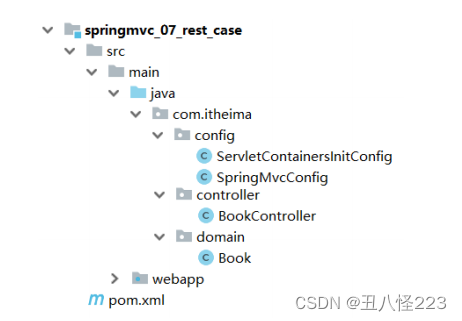
5.4.2
后台接口开发
步骤
1:
编写
Controller
类并使用
RESTful
进行配置
@RestController
@RequestMapping
(
"/books"
)
public class
BookController
{
@PostMapping
public
String
save
(
@RequestBody
Book book
){
System
.
out
.
println
(
"book save ==> "
+
book
);
return
"{'module':'book save success'}"
;
}
@GetMapping
public
List
<
Book
>
getAll
(){
System
.
out
.
println
(
"book getAll is running ..."
);
List
<
Book
>
bookList
=
new
ArrayList
<
Book
>
();
Book book1
=
new
Book
();
book1
.
setType
(
"
计算机
"
);
book1
.
setName
(
"SpringMVC
入门教程
"
);
book1
.
setDescription
(
"
小试牛刀
"
);
bookList
.
add
(
book1
);
Book book2
=
new
Book
();
book2
.
setType
(
"
计算机
"
);
book2
.
setName
(
"SpringMVC
实战教程
"
);
book2
.
setDescription
(
"
一代宗师
"
);
bookList
.
add
(
book2
);
Book book3
=
new
Book
();
book3
.
setType
(
"
计算机丛书
"
);
book3
.
setName
(
"SpringMVC
实战教程进阶
"
);
book3
.
setDescription
(
"
一代宗师呕心创作
"
);
bookList
.
add
(
book3
);
return
bookList
;
}
}
步骤
2
:使用
PostMan
进行测试
测试新增
{
"type"
:
"
计算机丛书
"
,
"name"
:
"SpringMVC
终极开发
"
,
"description"
:
"
这是一本好书
"
}
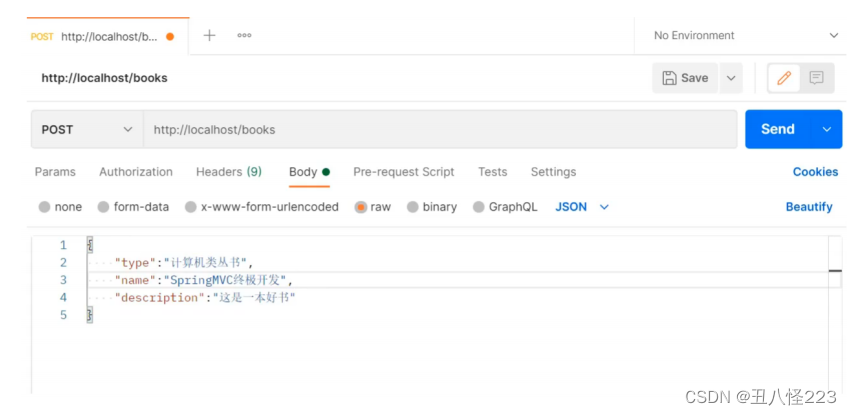
测试查询
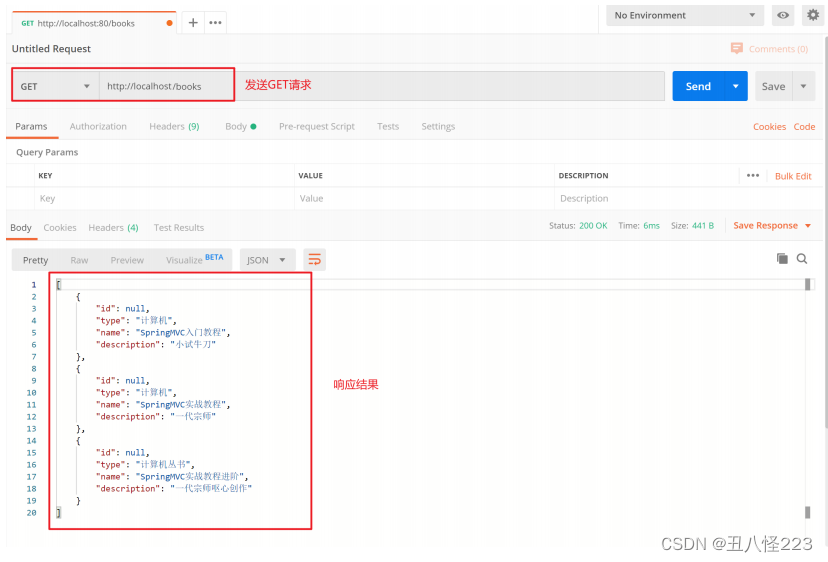
3 . 页面访问处理
步骤
1:
拷贝静态页面
将
资料
\
功能页面
下的所有内容拷贝到项目的
webapp
目录下
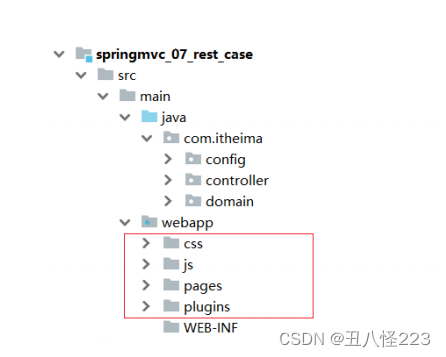
步骤
2:
访问
pages
目录下的
books.html
打开浏览器输入
http://localhost/pages/books.html

(1)
出现错误的原因
?

SpringMVC
拦截了静态资源,根据
/pages/books.html
去
controller
找对应的方法,找不到所以
会报
404
的错误。
(2)SpringMVC
为什么会拦截静态资源呢
?
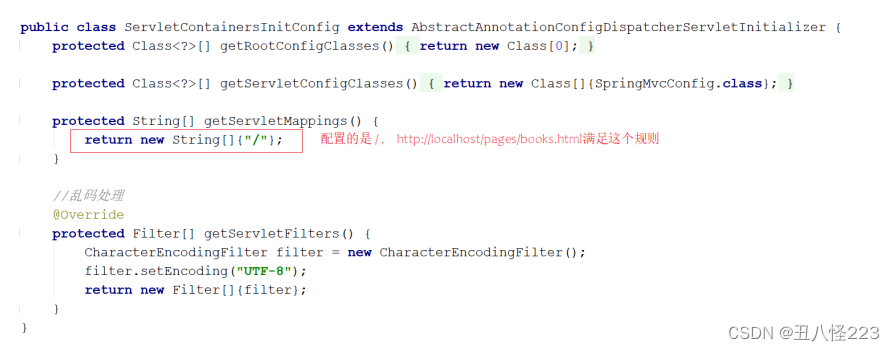
(3)
解决方案
?
- SpringMVC需要将静态资源进行放行。
1
@Configuration
2
public class
SpringMvcSupport
extends
WebMvcConfigurationSupport
{
3
//
设置静态资源访问过滤,当前类需要设置为配置类,并被扫描加载
4
@Override
5
protected
void
addResourceHandlers
(
ResourceHandlerRegistry registry
) {
6
//
当访问
/pages/????
时候,从
/pages
目录下查找内容
7
registry
.
addResourceHandler
(
"/pages/**"
).
addResourceLocations
(
"/pages/"
);
8
registry
.
addResourceHandler
(
"/js/**"
).
addResourceLocations
(
"/js/"
);
9
registry
.
addResourceHandler
(
"/css/**"
).
addResourceLocations
(
"/css/"
);
10
registry
.
addResourceHandler
(
"/plugins/**"
).
addResourceLocations
(
"/plugins/"
)
;
11
}
12
}
13
- 该配置类是在config目录下,SpringMVC扫描的是controller包,所以该配置类还未生效,要
想生效需要将
SpringMvcConfig
配置类进行修改
@Configuration
@ComponentScan
({
"com.itheima.controller"
,
"com.itheima.config"
})
@EnableWebMvc
public class
SpringMvcConfig
{
}
或者
@Configuration
@ComponentScan
(
"com.itheima"
)
@EnableWebMvc
public class
SpringMvcConfig
{
}
步骤
3:
修改
books.html
页面
<!DOCTYPE html>
<html>
<head>
<!--
页面
meta -->
<meta
charset
=
"utf-8"
>
<title>
SpringMVC
案例
</title>
<!--
引入样式
-->
<link
rel
=
"stylesheet"
href
=
"../plugins/elementui/index.css"
>
<link
rel
=
"stylesheet"
href
=
"../plugins/font-awesome/css/font
awesome.min.css"
>
<link
rel
=
"stylesheet"
href
=
"../css/style.css"
>
</head>
<body
class
=
"hold-transition"
>
<div
id
=
"app"
>
<div
class
=
"content-header"
>
<h1>
图书管理
</h1>
</div>
<div
class
=
"app-container"
>
<div
class
=
"box"
>
<div
class
=
"filter-container"
>
<el-input
placeholder
=
"
图书名称
"
style
=
"width:
200px;"
class
=
"filter-item"
></el-input>
<el-button
class
=
"dalfBut"
>
查询
</el-button>
<el-button
type
=
"primary"
class
=
"butT"
@click
=
"openSave()"
>
新建
</el-button>
</div>
30
<el-table
size
=
"small"
current-row-key
=
"id"
:data
=
"dataList"
stripe highlight-current-row
>
31
<el-table-column
type
=
"index"
align
=
"center"
label
=
"
序号
"
></el-table-column>
32
<el-table-column
prop
=
"type"
label
=
"
图书类别
"
align
=
"center"
></el-table-column>
33
<el-table-column
prop
=
"name"
label
=
"
图书名称
"
align
=
"center"
></el-table-column>
34
<el-table-column
prop
=
"description"
label
=
"
描述
"
align
=
"center"
></el-table-column>
35
<el-table-column
label
=
"
操作
"
align
=
"center"
>
36
<template
slot-scope
=
"scope"
>
37
<el-button
type
=
"primary"
size
=
"mini"
>
编辑
</el-button>
38
<el-button
size
=
"mini"
type
=
"danger"
>
删除
</el-button>
39
</template>
40
</el-table-column>
41
</el-table>
42
43
<div
class
=
"pagination-container"
>
44
<el-pagination
45
class
=
"pagiantion"
46
@current-change
=
"handleCurrentChange"
47
:current-page
=
"pagination.currentPage"
48
:page-size
=
"pagination.pageSize"
49
layout
=
"total, prev, pager, next, jumper"
50
:total
=
"pagination.total"
>
51
</el-pagination>
52
</div>
53
54
<!--
新增标签弹层
-->
55
<div
class
=
"add-form"
>
56
<el-dialog
title
=
"
新增图书
"
:visible.sync
=
"dialogFormVisible"
>
57
<el-form
ref
=
"dataAddForm"
:model
=
"formData"
:rules
=
"rules"
label-position
=
"right"
label-width
=
"100px"
>
58
<el-row>
59
<el-col
:span
=
"12"
>
60
<el-form-item
label
=
"
图书类别
"
prop
=
"type"
>
61
<el-input
v
model
=
"formData.type"
/>
62
</el-form-item>
63
</el-col>
64
<el-col
:span
=
"12"
>
65
<el-form-item
label
=
"
图书名称
"
prop
=
"name"
>
66
<el-input
v
model
=
"formData.name"
/>
67
</el-form-item>
68
</el-col>
69
</el-row>
70
<el-row>
71
<el-col
:span
=
"24"
>
72
<el-form-item
label
=
"
描述
"
>
73
<el-input
v
model
=
"formData.description"
type
=
"textarea"
></el-input>
74
</el-form-item>
75
</el-col>
76
</el-row>
77
</el-form>
78
<div
slot
=
"footer"
class
=
"dialog-footer"
>
79
<el-button
@click
=
"dialogFormVisible =
false"
>
取消
</el-button>
80
<el-button
type
=
"primary"
@click
=
"saveBook()"
>
确定
</el-button>
81
</div>
82
</el-dialog>
83
</div>
84
85
</div>
86
</div>
87
</div>
88
</body>
89
90
<!--
引入组件库
-->
91
<script
src
=
"../js/vue.js"
></script>
92
<script
src
=
"../plugins/elementui/index.js"
></script>
93
<script
type
=
"text/javascript"
src
=
"../js/jquery.min.js"
></script>
94
<script
src
=
"../js/axios-0.18.0.js"
></script>
95
96
<script>
97
var
vue
=
new
Vue
({
98
99
el
:
'#app'
,
100
101
data
:{
102
dataList
: [],
//
当前页要展示的分页列表数据
103
formData
: {},
//
表单数据
104
dialogFormVisible
:
false
,
//
增加表单是否可见
105
dialogFormVisible4Edit
:
false
,
//
编辑表单是否可见
106
pagination
: {},
//
分页模型数据,暂时弃用
107
},
108
109
//
钩子函数,
VUE
对象初始化完成后自动执行
110
created
() {
111
this
.
getAll
();
112
},
113
114
methods
: {
115
//
重置表单
116
resetForm
() {
117
//
清空输入框
118
this
.
formData
=
{};
119
},
120
121
//
弹出添加窗口
122
openSave
() {
123
this
.
dialogFormVisible
=
true
;
124
this
.
resetForm
();
125
},
126
127
//
添加
128
saveBook
() {
129
axios
.
post
(
"/books"
,
this
.
formData
).
then
((
res
)
=>
{
130
131
});
132
},
133
134
//
主页列表查询
135
getAll
() {
136
axios
.
get
(
"/books"
).
then
((
res
)
=>
{
137
this
.
dataList
=
res
.
data
;
138
});
139
},
140
141
}
142
})
143
</script>
144
</html>

